






BURN HOT SAUCE • PIG TALE • WHISKEY HILL FARM CAT & CLOUD • CANNABIS BOWL OF THE WORLD? • POP-TARTS FEEDING FIREFIGHTERS • PARSNIPS • THE HIGHLANDS Monterey and San Benito Counties Winter 2016 • Number 22 Member of Edible Communities edible MONTEREY BAY

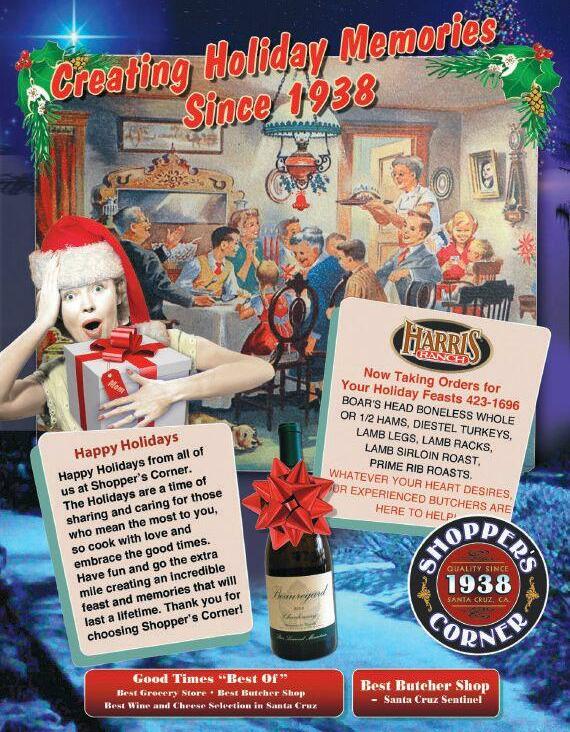
Cat & Cloud brews community, A chef keeps his kitchen open for the firefighters at the Santa Lucia Preserve
Celebrating a deceptively delicious and versatile winter root
EDIBLE ARTISANS BURN HOT SAUCE A local chef and farmer create a condiment like no other
HOME ON THE RANGE CALIFORNIA KUROBUTA How a Hollister family bet its farm on a pig and wound up raising worldclass pork
WINTER MONTEREY BAY FARMERS’ MARKETS online at www.ediblemontereybay.com
COVER AND CONTENTS Photos by Amanda Pargh
RECIPES IN THIS ISSUE:

31Simple Kurobuta Pork Roast from California Kurobuta More online at www.ediblemontereybay.com:
• Seafood Bouillabaisse from Santa Lucia Preserve
• Parsnip Hazelnut Gratin from Assembly
• Parsnip Nutmeg Ice Cream from e Penny Ice Creamery
• Grilled Turmeric Chicken Breast from Ella’s at the Airport
• Butternut Squash Soup from California Market at Pacific’s Edge
• Homemade Pop-Tarts from Happy Girl Kitchen
2 edible MONTEREY BAYWINTER 2016 4 GRISTFORTHEMILL 7
EDIBLENOTABLES
15
WHAT’S IN SEASON PARSNIPS
18
26
32
STILL
40 EDIBLE
ITS
44
Empowering
47 DINE LOCAL GUIDE 61 WINTER 2016 LOCAL SOURCE GUIDE 64 LAST CALL HOT
An
Contents
22 ON THE FARM CANNABIS BOWL OF THE WORLD? Marijuana legalization promises challenges as well as opportunities for the Monterey Bay agricultural community
EDIBLEINNOVATORS
FARMING Organic vegetables and “the world’s second oldest profession” go hand in hand on Whiskey Hill
ICONS READY FOR
NEXT CHAPTER A century later, the Highlands is still a pioneer
PRESERVATIONIST HOMEMADE POP-TARTS
children to cook—even their own “junk food”—is good for everyone
CHOCOLATE
illustrated guide to a singular winter treat
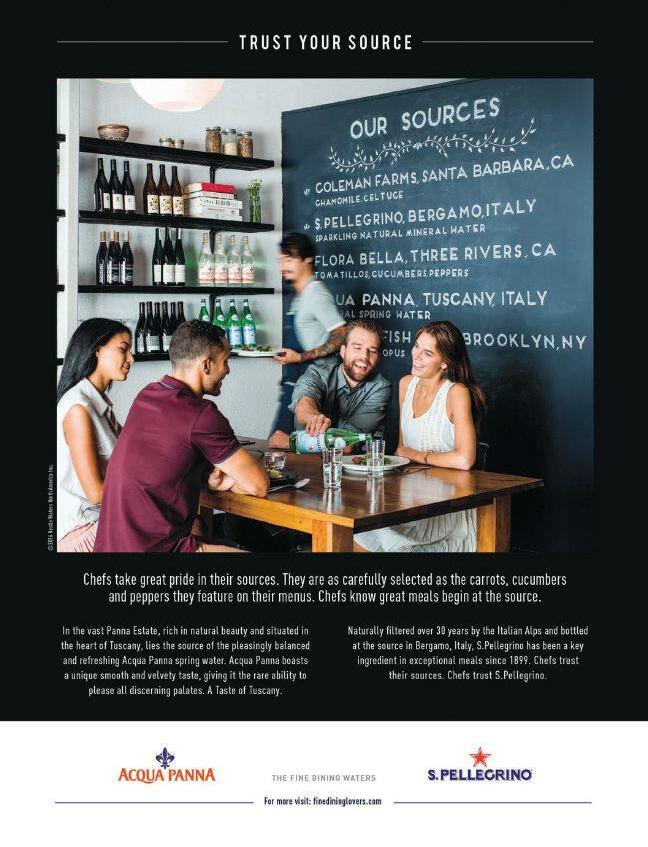
GRIST FOR THE MILL
Nothing defines the Monterey Bay area’s local food scene and our local food itself more than our farmers. Just as the seafood from our namesake bay and the foraged delicacies from our coastal woodlands, the remarkably diverse and prodigious harvest of our farms and ranches fires the imaginations of our chefs, food artisans and home cooks. And ultimately, it’s the bounty of our farms and ranches that makes up most of the local food on our plates.
If you’ve met any of them, you also know that our farmers are some of our region’s most fascinating people.
Yet unless you live on a farm or are lucky enough to count some of our farmers among your friends, odds are you seldom get a chance to step onto a local farm. And if that’s the case, you’re really missing out.
So it’s a huge pleasure, with this issue of Edible Monterey Bay, to give you the gift of an armchair trip to visit some of our most interesting farmers and ranchers.
You’ll read about the family in Hollister that bet its farm on a pig and wound up raising world-class pork, and the visionary duo behind a new enterprise that brings together medicinal and culinary tropical plants, organic vegetables, alternative fuel and whiskey into one astonishing symbiotic business in Freedom.
We share how the legalization of marijuana is already impacting our local agricultural community, and why seeking out parsnips from local farmers with the patience to raise these slow-growing, yet exceptionally sweet and complex roots is worth the effort.
You’ll also learn the tale behind the vibrant fermented hot sauce that enlivens the food on the cover of this issue—including how a chance load of serrano pepper seconds brought home by an aspiring farmer to his chef girlfriend spawned one of the region’s most exciting new food businesses.
We also explore the starring role the products of our local farms are playing in putting one the Monterey Peninsula’s most iconic restaurants at the vanguard of national food trends—even as it turns 100.
Rounding out this edition, you’ll find an article on an inspiring new coffee business in Santa Cruz and the story of how, as the Soberanes Fire approached, one chef kept his kitchen open to feed the firefighters.
Finally, since winter is ultimately a season of indulgence when it comes to food and drink, we offer a story about getting kids interested in cooking by, among other things, encouraging them to make their own junk food, and an illustrated cultural history of hot chocolate.
We wish you a joyous holiday season and many winter nights filled with luscious, healthful food and great reading!
Cheers,
Sarah Wood and Rob Fisher Publishers

edible
MONTEREY BAY
PUBLISHER AND EDITOR Sarah Wood
Sarah@ediblemontereybay.com 831.298.7117 or 831.238.1217
CO–PUBLISHER AND ASSOCIATE EDITOR Rob Fisher DEPUTY AND DIGITAL EDITOR Deborah Luhrman
COPY EDITOR Doresa Banning
LAYOUT DESIGN Melissa Petersen
SOCIAL MEDIA MANAGER Katie Reeves
EDITORIAL ASSISTANT Rosie Parker
AD DESIGN Dina Clark • Bigfish Smallpond
Design • Jane Bolling Design • Marilet Pretorius Melissa oeny Designs
CONTRIBUTORS Jordan Champagne
Jamie Collins • Bambi Edlund • Zoe Fisher
Larry Gerbrandt • Margaux Gibbons
Michelle Magdalena • Camilla M. Mann
Kathryn McKenzie • Amanda Pargh
Rosie Parker • Ken Payton • Amber Turpin Patrice Vecchione
ADVERTISING SALES
ads@ediblemontereybay.com • 831.298.7117
Shelby Lambert 831.238.7101 Kate Robbins 831.588.4577
Ola Rocha 802.734.7635 Sarah Wood 831.238.1217
DISTRIBUTION MANAGER


Mick Freeman/Newspaper Taxi 831.419.2975
CONTACT US:
Edible Monterey Bay P.O. Box 228, Carmel Valley, CA 93924 www.ediblemontereybay.com 831.298.7117 or 831.238.1217 info@ediblemontereybay.com
Edible Monterey Bay is published quarterly. All rights reserved. No part of this publication may be used without written permission of the publisher. Subscriptions are $28 per year at www.ediblemontereybay.com. Every effort is made to avoid errors, misspellings and omissions. If, however, an error comes to your attention, please accept our apologies and notify us. We also welcome letters to the above address. ank you.
4 edible MONTEREY BAYWINTER 2016
Photo by Zoe Fisher



6 edible MONTEREY BAYWINTER 2016
EDIBLE NOTABLES CAT & CLOUD
Verve alums brew new coffee community



 BY AMBER TURPIN
BY AMBER TURPIN
Meticulously sourced, roasted, brewed and presented coffee is paramount for Cat & Cloud, a new micro-roastery and coffee shop in the Pleasure Point area of Santa Cruz. But when you talk with the three owners—Chris Baca, Jared Truby and Charles Jack—it becomes clear that people are almost as important as the coffee.
is is demonstrated by the eclectic and diverse crew working at Cat & Cloud, chosen from a pool of 70 applicants in, what Baca describes as, “a values-based and behavioral-based interviewing method.” e strategy found “diamonds in the rough,” not necessarily the typical coffeehouse staff one might expect. “We look for people who align with our values,” he explains, meaning not just some one who can foam milk.
ose values are connection, community, education, integrity, kindness and, of course, respect for the almighty coffee bean. All of that goes in both directions, and the company gives back to its employees in very unusual ways. “We really believe that they are the only
way we can be successful. If we don’t take care of our employees and support them, then we can’t make it,” says Jack.
Proof is in the company’s generous benefits program, which includes four weeks’ paid time off for all full-time staff members. “Being able to have those reset moments is super rare in the service industry,” says Baca.
ere is also monthly profit sharing and everyone on staff gets to throw their name into a hat for the chance to tag along on trade shows, competitions and even global coffee-buying trips , creating a deeper level of education and life investment. To top it off, all employees get a health care allowance each month. “We don’t hear about many people doing that, and I think we need to raise the bar,” says Jack.
New brewers on the block: Clockwise from upper left, owners Chris Baca and Jared Truby with their roaster; Truby with, from left, Dan Garsha and Jason Ferrall; and Ferrall making espresso.
www.ediblemontereybay.com 7
Photos lower left and upper right by Jenn Chen, others courtesy of Cat & Cloud
e three friends have set a pretty high bar themselves within the specialty coffee community. All of them have deep history working at Santa Cruz-based Verve Coffee. Truby and Baca implemented new systems within the company and were barista champions, appearing on the cover of Barista Magazine, while Jack was doing work in Ethiopia and South Sudan with TechnoServe, a project that strives to improve production and opportunities for small-scale coffee farmers.
Ultimately, the time came to take a next step. “You have all these creative ideas, but until you own your own business, you are not allowed to really be you,” says Truby. eir first step was roasting, which they started in July 2015, launching an online subscription service while they refined their roasting style. At the time, Truby was still working at e French Press and Castle Coffee Roasters in Santa Barbara, owned by friends Todd Stewart and Julia Mayer. ey generously let Truby and Baca use their facility to roast, pack and ship out the first batches of Cat & Cloud beans.

One of the results of those early roasting days is now their signature blend called “e Answer.” Used for both espresso drinks and brewed coffee, it is a blend of beans from Colombia, Brazil and Ethiopia. “Our coffee is the approachable third wave coffee,” says Truby. “e idea is that we roast in such a way that we can keep all the complexities that people like in specialty coffee, but without the parts that people don’t tend to like.”
eir creative ideas are also expressed at the shop, where the trio outsourced many of the design elements to California artists they admire, another nod to the people-centric theme behind Cat & Cloud. ey showcase vibrant paintings by local artist Nick Vargas, who emblazoned the Cat & Cloud logo in a colorful wall mural. e logo originated as a whimsical sketch by coffee pal Julia Mayer. She drew the Cat (Baca) and Cloud (Truby) for them to use for their podcast, originally called Trubaca—a combination of their names.
ere is intricat e woodwork by Janine Stone and astounding tiles by Mikey Gaumann, a highly creative couple based in San Luis Obispo.
Cups and plates were made by potter Sean White of Flat White Ceramics in Petaluma, who also happens to be a fellow coffee roaster. e roaster itself was custom made in the signature Cat & Cloud turquoise and is brightly displayed for all to see within a glass-walled section of the shop.
Truby and Baca’s weekly podcast, on all things coffee, draws fans and friends from around the world, while Monday morning pop-ups at Companion Bakeshop have built up their following closer to home. Companion switched from using San Francisco-based Four Barrel Coffee to Cat & Cloud in August, marking its first wholesale account, and the bakeshop provides all the food for the café as well in an exclusive partnership.
Companion owner Erin Lampel says, “Cat & Cloud is all about quality coffee from sourcing, roasting and serving. It became clear to me that these guys are doing something they are passionate about and sharing it with their community here in Santa Cruz. ey care about giving people a GREAT experience. It’s not pretentious in any way, which is refreshing and welcoming.”
You can’t help but notice that Cat & Cloud is just a few blocks away from the original Verve location on 41st Avenue and almost directly across the street from the flagship Coffeetopia. But no one is complaining—in fact, much like the collegial brewers behind Santa Cruz’s thriving craft beer scene, the city’s roasters have a more-the-merrier attitude towards one another. “A rising tide floats all boats,” says Baca.
Amber Turpin is a freelance food and travel writer based in the Santa Cruz Mountains.
Cat & Cloud 3600 Portola Drive, Santa Cruz • www.catandcloud.com

8 edible MONTEREY BAYWINTER 2016




www.ediblemontereybay.com 9

EDIBLE NOTABLES
A CHEF FEEDS THE FIREFIGHTERS
As the Soberanes Fire approached Carmel’s Santa Lucia Preserve, chef Jerry Regester kept the kitchen open
 BY PATRICE VECCHIONE PHOTOGRAPHY BY KEN PAYTON
BY PATRICE VECCHIONE PHOTOGRAPHY BY KEN PAYTON
If the Soberanes Fire feels far away and a long time ago, look up at any number of the bare mountainsides where, just months ago, trees grew aplenty, and memories of the long-bu rning fire will return to you in an instant. It took until mid-October to contain the more than 130,000acre fire that began in late July, and its mark is still striking.
For Jerry Regester, executive chef for the Santa Lucia Preserve, the fire may be a part of his spiritual and culinary present tense for a long time to come. He’s one of those—many of them local chefs—who actually did something of value while I paced the floors, smelled the smoke and listened to the planes, feeling helpless.
South of Carmel, back in the hills, sits Rancho San Carlos, land that for more than 1,500 years was home to the Rumsen tribes and eventually became a private ranch. Known now as the Santa Lucia Pre-
serve, it’s largely protected save for the limited number of exclusive homes that dot its 20,000 acres.
e preserve s erved an important function during the fire. Because it was situated between where the fire started in Garrapata State Park and Carmel Valley, fire crews were able to make defensible space there that helped prevent the fire from moving down into Carmel Valley where, if it had, many people and much property would have been in serious danger.
Not only did Regester, who lives onsite, and others at the preserve smell the smoke, but flames were visible just over the hilltops. e fire was moving rapidly toward them from Garzas Creek. Seeing those flames made everybody nervous. As the fire grew, all but essential staff left the property. Most of the homeowners departed, too.
www.ediblemontereybay.com 11
“I’machef.at’smypartofthepuzzle. Iwouldn’thavebeenabletosleepifIhadn’tbeenhelping.” Remembering
the fire: from left, chef Jerry Regester, firefighter Joshua Terry and chief Michael Urquides in Regester’s kitchen garden.
Because the Hacienda, the preserve’s dining room, a gorgeous adobe built in the 1920s, would be closed and he wouldn’t be preparing the typical roughly 80 dinners an evening, let alone cooking for several parties that had to be canceled, Regester took his girlfriend up on her invitation for a round of golf.
But while out on the course, Regester tells me, he was distracted. He kept thinking about his kitchen that was full of food he’d planned to prepare.

“I wasn’t enjoying myself. Having gotten away for a few hours, I realized that what I really wanted to do was something to help those who were helping us, those on the front lines fighting the fire, working in all that heat and smoke, up close to the flames.”
Without finishing his golf game, Regester got back in his truck and returned to the preserve just as the fire was getting worse.
e first meal he made for the fire crews and everyone who was working to get an upper hand on the blaze—from sheriffs to the road crew to the bulldozer operators—was a bouillabaisse. “I had all this fish in the refrigerator—clams, mussels, crab.”
Word that dinner was on the way got around quickly. “I put this enormous pot in my truck and drove it up to the break room at the shop.” e firefighters helped carry the assorted pots and pans inside. Suddenly, there was a hungry crowd. By the third day, there was a line of people asking, “What are you making today, chef?”
Each day, he’d open the fridge, look in the cupboards, grab what he was inspired by and begin to cook. Much of the food that’s prepared at the Hacienda comes from its acre-plus kitchen garden where there are the expected vegetables growing including various herbs, tomatoes, kale and lettuce but also the unexpected, such as a 7-foot-tall cardoon!
When head gardener Nicky omas hears why I’m getting a tour of the garden, she says, “You can’t leave a chef standing around doing nothing!” Apparently not.
Regester prepared ribs one day and butter bean with bacon soup another. He made various salads, garlic bread—food to soothe nerves and fill the stomachs of people working extremely hard in a treacher-

ous environment. He tells me he likes to serve what’s fresh, that he shies away from freezing food. “ere was all this ricotta and fresh mozzarella,” he said, “so I made big pans of lasagna.”
Chef Regester wasn’t the only one at the preserve cooking for the workers. Some of the homeowners who’d stayed made batch after batch of cookies. But since he was the only one in the kitchen, not only did Regester, who’s been at the preserve for two and half years, cook but he became chief bottlewasher as well, doing dishes and mopping the floors. Regester says, “All of us at the preserve felt an obligation to do what we could to hold the fire line so it wouldn’t go any farther.”
Monterey County Regional Fire District Chief Michael Urquides tells me that all the workers enjoyed the meals: “A home-cooked meal goes a long way. ere wasn’t a thing that didn’t get eaten. It was all gobbled up.”
Noting the deeper meaning that came come from eating well together, Urquides continues, “From a morale standpoint, it was tremendous. e firefighters, being away from home for so long, get used to eating rather repetitive meals, mostly sandwiches, prepared by vendors.”
Regester’s food wasn’t only delicious; it didn’t just uplift morale and unify the community, concludes Urquides. “It was good for the workers’ health.”
Reflecting back on that time, as we sit on the Hacienda patio on a cool morning, the effects of the fire visible only a short distance away, Regester tells me he felt better being usef ul. “I’m a chef. That’s my part of the puzzle. I wouldn’t have been able to sleep if I hadn’t been helping.”
Monterey artist and author Patrice Vecchione’s latest book is Step into Nature: Nurturing Imagination and Spirit in Everyday Life. For more, go to www.patricevecchione.com.
RECIPE: See www.ediblemontereybay.com/recipes for the seafood bouillabaisse that Regester made for the firefighters.
12 edible MONTEREY BAYWINTER 2016



14 edible MONTEREY BAYWINTER 2016
WHAT’S IN SEASON PARSNIPS
Celebrating a deceptively delicious and versatile winter root
BY JAMIE COLLINS PHOTOGRAPHY BY CAMILLA M. MANN
Parsnips are one of my favorite root vegetables as their flavor is sweet yet complex and complements so many winter dishes. I’ve enjoyed them roasted with other roots for as long as I can remember, but my very first time cooking a rabbit is when I really fell for them. I wrapped the rabbit in bacon and roasted it in a pan filled with chunks of parsnips, butternut squash and purple sweet potatoes that I had covered in coconut milk seasoned with nutmeg and cardamom. ere was no going back—I was in love with the deep earthy flavor and buttery sweetness that the parsnip deployed and the way the coconut milk turned the roots into a rich dessert-like side dish.
Parsnips are also especially appreciated by some of our local chefs.

“I love their sweetness and their nutty quality, and they pair well with so many things, especially as we head into the colder season,” says Kendra Baker, who is the co-founder of Assembly Restaurant, e Picnic Basket and e Penny Ice Creamery in Santa Cruz and provided the recipes for a parsnip ice cream and a parsnip gratin that accompany this story. “ey have a texture unto themselves that’s alluring— a real creaminess and real velvety texture, and also a counter texture akin to a pear.”
“Parsnips are super underutilized; they have a high sugar content which makes them great in both savory and sweet preparations,” says Kyle Odell, previously chef at Carmel Belle who now applies his culinary creativity to cocktails at Cultura in Carmel. “My favorite and the most unique parsnip dish is one I made while working at a restaurant in a luxury resort in San Francisco—quail ragu on top of a parsnip custard. Basically you slice and peel the parsnips and cook them in milk, then buzz them up with a little olive oil. Use a basic custard recipe— 6 egg yolks, 1 whole egg, 1 pint of milk, 1 pint of cream and add 1 pint of the parsnip purée.”
But even though parsnips’ flavor is quite delicious and versatile, one doesn’t often find parsnips for sale at the far mers’ market, and I only find a few limp specimens on grocery store shelves now and then. So where did parsnips come from and why aren’t they more popular?
www.ediblemontereybay.com 15
Parsnips (Pastinaca sativa) are closely related to parsley and carrots but contain more starch, which converts to the sugars they are known for when they are left in the ground in cold weather and when they are cooked. Parsnips also have a nutty flavor that is unique to them, and they are good for you: they are high in potassium, various B vitamins, antioxidants and fiber, and they may help fight cancer and inflammation.
Historically, parsnips were used as a sweetener in Europe before cane sugar was imported and the quick-growing sugar beet replaced them. Introduced to the United States in the 1900s, parsnips were once a staple in the American diet. But being slow growers (they take 120 days to mature—nearly twice as long as carrots), parsnips were gradually replaced by other roots that performed better and took less time to grow, like beets, potatoes, sweet potatoes and of course carrots. And they also are not the most attractive vegetable around, looking somewhat like anemic carrots!
Local farms that do go to the trouble to grow this delicious root include Route 1 Farms in Santa Cruz, Pinnacle in Hollister and Live Earth Farm in Watsonville.
Taylor Poudrier, Live Earth’s sales and marketing manager, says the farm never seems to be able to grow enough parsnips; they always sell out quickly. Live Earth harvests through the winter as needed, giving the roots that remain in the ground a chance to get sweeter as the winter progresses.
GROWING, SELECTING AND STORING PARSNIPS

Like most root crops, parsnips prefer a deep, well-worked sandy loam soil with no big rocks that can deform the roots while they are trying to grow.
Parsnips are planted in the spring and direct seeded ½-inch deep and 18 inches apart. Parsnip seeds take up to three weeks to germinate which is much slower than weed seeds’ germination time, so effort must be taken to ensure that the parsnip seedlings don’t get choked out by the interlopers. Plants should be thinned to 2–3 inches apart and wa-
t
ered enough to keep them moist, but not too much because doing so can increase wireworm and carrot or celery maggot populations.
When selecting parsnips at the market or grocery store, look for blemish-free, firm, small-to-medium roots as those that are very large may have a tough, woody center. But if all you can find are large specimens, you can remove the woody center with a knife and use the flesh surrounding it instead. Avoid parsnips that have micro roots coming off the main taproot—this means they were searching for water and are probably dry and not as delicious.
If you can find some with their greens attached, snatch them up; this is a sure sign they are fresh. However, do be careful handling the greens, as the sap—the parsnip’s natural defense against herbivores like rabbits and deer—is toxic and can cause a chemical burn on the skin similar to poison oak in people sensitive to it.
Parsnips can last several weeks, if not months, in cold storage and are best stored unwashed and dry in a plastic bag in the refrigerator.
When you want to cook them, scrub well but try to resist the urge to peel them—unless they are not organic—as the skins have lots of flavor as well as fiber, which lowers blood cholesterol levels.

BRING BACK THE PARSNIPS!
Parsnips can be eaten raw—think very thinly sliced with chunks of citrus like blood oranges or pink grapefruit, a good feta and fresh herbs for a tasty seasonal salad—but the flavor is not as complex or sweet as compared to a roasted or baked one.
Steam, sweat, boil, roast, mash, stir-fry or purée—any preparation style will yield satisfying and delicious parsnips as cooking brings out their sweetness.
Chop parsnips and include in stews, gratins or casseroles; make a cream of parsnip soup; bake parsnip chips; and remember herb and garlic play well with the parsnip as do warm spices like cinnamon, nutmeg, cardamom and cloves.
Kids will love parsnips, especially since they gravitate towards white foods. Try them puréed or roasted with butter a nd add a dash of cinnamon and sea salt.
16 edible MONTEREY BAYWINTER 2016
SOMEOFMYFAVORITEWAYS
TO ENJOY PARSNIPS:
• Cut parsnips in chunks and cover halfway with coconut milk, add salt, nutmeg and cardamom and some chopped sweet onions, kale and chard and, if desired, chicken breasts or legs. Roast uncovered at 350° F for about an hour or until the chicken is done. Let the coconut milk cook down and become gravy like and serve with brown rice.
• Cut parsnips into strips, toss with olive oil and sea salt and spread single layer on a pan. Roast for 10 minutes at 375°, turn them over and bake another 10 minutes, remove and toss them with some pomegranate molasses.
• Coat parsnips and sliced Granny Smith apples with olive oil (or even bette r, walnut oil) and sea salt. Roast and then blend with chicken stock, fresh Italian parsley and a sweet onion or shallot roux for a sweet winter soup. Add cream or crème fraîche and a bit of nutmeg before serving.
• Do a 50/50 parsnip and potato mash, blending in roasted garlic and rosemary.
• Try using parsnips instead of carrots in a carrot cake for a rooty twist.
• Toss chunks of parsnips and Brussel s sprouts in oil and salt and roast at 375° for 15 minutes, turn and roast for another 15 minutes. Put in a bowl; add orange zest, black pepper, sliced almonds and a splash of white wine vinegar. e sweetness of the parsnip pairs well with the bitterness of the Brussels.
• Add parsnips to soup stock to thicken and add depth of flavor. Parsnips can be removed before serving if desired.
Jamie Collins is owner of Serendipity Farms, which grows organic row crops in Monterey and Santa Cruz counties and distributes them through a CSA, u-picks and farmers’ markets.
RECIPES: See www.ediblemontereybay.com/recipes for Kendra Baker’s recipes for Parsnip Hazelnut Gratin and Parsnip Nutmeg Ice Cream.
LOCALFOODS IN SEASON
December, January and February
Fruits: Apples • Asian Pears • Avocados • Grapefruits Grapes • Guavas • Kiwis • Kumquats • Lemons • Limes Mandarins • Oranges • Parsnips • Pears • Persimmons Pomegranates* • Pomelos
Vegetables: Artichokes* • Arugula • Asparagus** • Beets • Bok Choy • Broccoli • Broccoli Raab • Brussels Sprouts • Burdock Cabbage • Cardoons • Carrots • Cauliflower • Celeriac • Celery Chard • Chicory • Collards • Cress • Dandelion • Endive • Fava Greens • Fennel • Garlic • Horseradish • Kale • Kohlrabi • Leeks Mushrooms • Mustard Greens • Nettles • Onions • Orach Parsnips • Potatoes • Radishes • Rutabagas • Salsify* • Shallots Spinach • Sprouts • Winter Squash • Sunchokes • Sweet Potatoes • Turnips
Fish: Abalone • Anchovies • Cazebon • Crab, Dungeness Crab, Rock • Flounder, Starry • Grenadier, Pacific • Herring Lingcod • Rock Cod, aka Rockfish • Sablefish, aka Black Cod Sanddabs, Pacific • Sole, Dover, Petrale and Rex • Spot Prawns * December only ** February only
All fish listed are rated “Best Choice” or “Good Alternative” by the Monterey Bay Aquarium’s Seafood Watch program. See www.montereybayaquarium.org/cr/seafoodwatch.aspx for more information. Research assistance from Real Good Fish and Serendipity Farms.
Winter 2016 Guide to Local Farmers’ Markets at www.ediblemonterey.com/local food guides


www.ediblemontereybay.com 17
EDIBLE ARTISANS BURN HOT SAUCE

A local chef and farmer create a condiment like no other
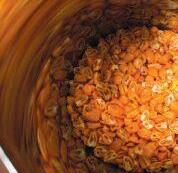 BY ROSIE PARKER PHOTOGRAPHY BY AMANDA PARGH
BY ROSIE PARKER PHOTOGRAPHY BY AMANDA PARGH
In an age when hot sauce is everyone’s favorite culinary accessory, Santa Cruz’s Burn Hot Sauce manages to burn the brightest. Wild fermented, probiotic packed, organic and rich in color and kick, its dazzling products make the company’s playful tagline “Wanna Burn?” an obvious rhetorical question. (For the record, this ringing endorsement comes from a writer who often finds garlic to be too spicy.)
Burn is the combined powers of farmerchef partners Chase Atkins and Amanda Pargh. Drawn to the symbiotic relationship of restaurant and farm, Pargh and Atkins relocated to Santa Cruz from Sonoma in 2014 to begin work at Michelin-starred Manresa and Love Apple Farms, respectively.
Shortly after their move, a fire at Manresa left Pargh (who had worked for years in prestigious kitchens like Animal and Lucques in Los Angeles and Ad Hoc in Yountville) with a flexible autumn, which she used to teach classes at Love Apple and experiment at home with all things fermentable. In the meantime, Atkins started to build relationships within the farming community through his job at Mountain Feed & Farm Supply in Ben Lomond and part-time work with various local farms.
By chance, it was helping with a pepper harvest at a Santa Cruz farm that provided Atkins with the fateful first load of peppers— 20 pounds of serrano pepper seconds—that he brought home to Pargh. But from the first vivid red batch of hot sauce they fermented, the couple knew they were on to something. “We had this vibrant product that favored flavor over spicy,” Atkins says, beaming. “As a chef, it’s important to make something that complements food, rather than competes with it,” Pargh adds.
e couple launched their business in April 2015, and in 18 months have grown from a first season of 200 gallons of hot sauce produced to the 3,000 gallons they were pro-
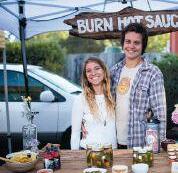
cessing for a winter release as this issue of Edible Monterey Bay went to press.

Pargh and Atkins’ method is deceptively simple: ey select, clean and slice vineripened, organic peppers and ferment them, still raw, with water and salt for 3–6 months in stainless steel vats. During this time, the yeast that is naturally occurring on the peppers is activated by the saltwater brine and converts the sugars in the peppers into lactic acid—a natural preservative that inhibits the growth of harmful bacteria. Fermentation also increases vitamin and enzyme levels in the pepper mixture, which in turn increases digestibility.
And unlike the process used by most hot sauce makers, which is to cook down the peppers and then add vinegar for tang, the naturally radiant colors and flavors of Burn’s different raw ferments truly showcase the peppers they are made from as well as the farms that grew them.
“It’s amazing how complex and nuanced the flavors get after fermentation,” Pargh says. “e serranos from 2015 are super citrusy and a little sharp on the tongue but fill the whole mouth with flavor, whereas the ai Bird has a sweet and mild start and then a sneak attack spicy that you can feel in your chest and unde r your eyes.”
In addition to the 2015 batches of ai Bird jalapeño and serrano, Burn offered their tamer alternative—“mild but wild,” Pargh likes to say—of cyklon sauce from Fire Tongue Farm in Hollister. e cyklon, tangy with the right amount of kick, allows even the most heat-wary customers to be part of the “hot sauce on everything” club.
Working with farms all over the Central Coast—and some from beyond—Burn
Farm to flavor: Pargh, pictured with Atkins this page, second image from bottom, tells a visual story of Burn through her prolific Instagram feed.
18 edible MONTEREY BAYWINTER 2016



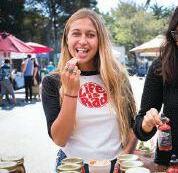

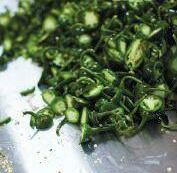





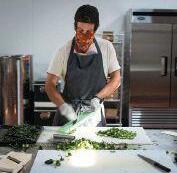
www.ediblemontereybay.com 19


20 edible MONTEREY BAYWINTER 2016
makes its sauces single-origin to allow the terroir of each heirloom variety to come through. “A serrano from Rose Ranch in Sonoma is going to be unique from a serrano from Old House Farm in the Santa Cruz Mountains,” Pargh explains. “It’s important to us to respect those distinctions.”
A desire for a no-waste product spawned two other Burn goodies—pickles and probiotic powde rs. Pargh could only pour one batch of post-fermentation pepper brine down the drain before starting to experiment with reusing the beautiful byproduct to pickle seasonal vegetables. e pickles—raw and wild-fermented like the hot sauce—maintain a freshness, crunch and intensity of color that quickly made them a farmers’ market hit.
From baby carrots pickled whole with dill, green garlic and cayenne to cyclone coriander ginger beets, the pickles ($7–$9 per jar) give Pargh a chance to really play in the kitchen. ey also offer an opportunity to highlight other local farms—Happy Boy, Blue Heron, Live Earth—that aren’t necessarily providing the company with peppers. Escabeche, the newest pickle line, was the perfect use for an abundance of green jalapeños in an otherwise slow growing season. It also is repurposed as an incredible brine for everything from bright golden beets to psychedelic pink radishes.
Burn’s honeycomb-hued probiotic powders ($3 per jar) are made from the fermented seeds and skins left after the hot sauce is passed through a sieve. ey are dehydrated at a low temperature so as to not kill off the probiotic properties, and then ground into a powder. Says Pargh, “It’s nutritional yeast meets chili powder—umami goodness that can be sprinkled on anything!”
Currently, you can find the hot sauce ($9 per bottle) at most New Leaf markets and at specialty stores all over the West Coast from Portland, Ore., to the Monterey Bay Aquarium. But for pickles, powders and Burn updates from the owners themselves, visit the downtown Santa Cruz farmers’ market every Wednesday, or the Felton, Live Oak, and Westside markets on a rotating schedule.
Anyone who has had the chance to meet the couple at a market knows that they are as vibrant as their technicolor ferments. Pargh effuses passion and focus, her face in a permanent open-mouthed grin, while Atkins is full of


warmth and knowledge. To approach their booth for a sample is to be welcomed into their home. “We are Burn,” Atkins emphasizes. “It’s important for us to be involved with our community and be at farmers’ markets to be able to share our vibe through our product.”
“It’s so special to be able to see first-hand people enjoying our creations,” Pargh chimes in. She often captures these first reactions of delight—and sometimes surprise at an unexpected zing—with her camera, which she then posts on Instagram, brightening Burn’s followers’ feeds with daily posts of product, preparations, process and, most important to Pargh and Atkins, people.
is winter, Burn will extend its lineup to include four new pepper varieties, including two habanero blends (habanero/orange bell pepper from JF Organic Farms in Chino and habanero/escamillo from Groundswell Farm in Santa Cruz) for those who like their hot sauce turned up to 11. e habaneros, as well as Bulgarian carrot pepper and golden cayenne sauces, will add vivid orange and yellow hues to an already eye-popping assortment. Some of the habaneros will even be aged in an agave spirit barrel from Venus Spirits for a VIP batch.
Other future plans include making prepared foods at markets and festivals. “We’re thinking market-inspired sandwiches and snacks,” Pargh says excitedly. “It’s a chance to put our product into play and promote many of the other vendors at the market.”
Gorgeous, delicious and good for both the eater as well as the planet, it’s no wonder Burn’s products have acquired something of a cult following. But Pargh herself remains awed at what she and Atkins are able to create with such simple methods.
“It’s amazing to see what these chili peppers become,” Pargh reflects. Organic peppers, water, salt and time are the main ingredients the couple lists on their website. “And love,” Atkins adds. “Definitely love.”
Rosie Parker, a native New Englander, likes to complain of missing home while living the Santa Cruz highlife—surfing, hiking, writing and working for a delicious craft brewery.
Burn Hot Sauce
www.burnhotsauce.com info@burnhotsauce.com
www.ediblemontereybay.com 21

22 edible MONTEREY BAYWINTER 2016
ON THE FARM
CANNABIS BOWL OF THE WORLD?
Marijuana legalization promises challenges as well as opportunities for the Monterey Bay agricultural community
 BY KATHRYN MCKENZIE • PHOTOGRAPHY BY KEN PAYTON
BY KATHRYN MCKENZIE • PHOTOGRAPHY BY KEN PAYTON
With the presidential campaign having held many local residents’ attention hostage during the 2016 election cycle, the passage by a margin of 56% to 44% of Proposition 64, the Adult Use of Marijuana Act, came as a surprise to many Monterey Bay area residents.
But for those in the local agricultural community, Prop 64 was a little more on the forefront of their minds, raisin g questions such as how it would affect land prices, whether they should consider moving to cannabis production, how many local food producers would do so, and how the newly legal crop would be regulated.
In Monterey, Santa Cruz and San Benito counties, which some say are well-positioned to exploit the passage of Prop 64, local agriculture agencies have been waiting and watching, as have some local farmers who are considering a switch to this potentially more lucrative crop. And investors have been busily positioning themselves to get in on the ground floor of the many millions—perhaps billions—of dollars that will be generated by cannabis cultivation, processing and recreational sales.
“I’m sure that people are putting together business plans and getting ready to make their move,” said Nesh Dhillon, Santa Cruz County Farmers’ Markets operations manager, just before the November election. Although Dhillon says he has no personal knowledge of farmers looking to jump on the marijuana bandwagon, he’s sure that it’s being discussed in the local agricultural community, and “you’d be foolish to show your hand at this point.”
Jamie Collins, owner of Serendipity Farms, which cultivates organic row crops in M onterey and Santa Cruz counties, says it wouldn’t surprise her at all if some small local farmers decide to grow cannabis to supplement their income. In casual conversations at
area farmers’ markets, she’s heard it discussed between the stalls.
“ey won’t just stop growing food,” says Collins, who envisions small farmers adding a marijuana greenhouse or two to complement the rest of their crops. “It’s hard to make a decent living (as a small farmer)…a lot of growers have it on their minds.”
But she her self chose to vote against Prop 64 because of various concerns about how cannabis cultivation would be regulated under the new rules, and where resulting tax money would be spent.
California—the first state in the nation to legalize medical marijuana, in 1996—was one of four states, including Massachusetts, Maine and Nevada, to vote in November to make recreational use legal, following similar moves in recent years by Alaska, Colorado, Oregon and Washington.
Under the terms of the initiative, which took effect immediately after the vote, Cali-
fornians 21 and older are able to possess and use small amounts of cannabis legally as well as grow up to six plants per household.
The next phase, according to the California Legalized website, is enactment of regulations, and then licensing, which kicks off lawful commercial activity—commercial cultivation, distribution, processing and sales by licensed non-medical entities—in January 2018.
Businesses involved will have to be licensed, regulated, and most importantly, taxed. In fact, six local measures were on the ballot for taxation of marijuana in Monterey County, with the potential of raising millions for cities and co unties that approve such taxes. Santa Cruz County has taxed medical marijuana since 2014, putting some $2.4 million annually into its general fund.
Prop 64 will also create two new state excise taxes on marijuana, with revenue used to cover costs of administrating and enforcing
www.ediblemontereybay.com 23
Cannabis attorney Gavin Kogan
the measure, as well as funding drug research and treatment. According to the California National Orga nization for the Reform of Marijuana Laws (NORML), as much as $1.2 billion per year could be raised from these taxes at the state level. Retail sales of cannabis could run from $3 to $4.5 billion a year; spinoff industries could generate as much as $18 billion, studies say.
Needless to say, it’s all pretty complicated, or as Dhillon puts it, “a whole big sticky mess.”
ere will be a variety of issues to work out between now and January 2018, and looming over all of this is the fact that according to federal law, cannabis is still illegal.

And despite all the talk about legalization, most of those involved in cannabis businesses are not anxious to discuss what they do. Requests to several local businesses were turned down or calls not returned; one reply says, “Looks like we have to pass this time around…after the vote, perhaps?”
Local counties have been preparing for the passage of AUMA, bolstered by the state’s passage of the California Medical Marijuana Regulation and Safety Act last year, which lays out licensing parameters and a regulatory framework for medical cannabis that will segue into licensing and regulation for recreational marijuana sales.
Santa Cruz County is already far ahead of the curve, with an online step-by-step guide to help existing cannabis farmers and pot-related businesses get a local license. e county even has its own designated cannabis licensing office.
Santa Cruz County communications manager Jason Hoppin says that a cultivation ordinance is now under review and will be put into place next year, which will spell out the time, place and manner of cultivation. Unlike Montere y County, Santa Cruz County allows cannabis to be grown outdoors, with most pot farms found in the mountain areas where the climate is most suitable.
Bob Roach, assistant agricultural commissioner for Monterey County, points out that the county board of supervisors recently passed ordinances for zoning and permits for growing medical marijuana, and included language in these ordinances that could be applied to expansion into growing on a larger scale for recreational use.
And taxes are necessary because there will be a lot more work involved: “It will be a huge regulatory burden for the county,” says Roach. “ere will be a lot of ongoing work that needs to be done for this new industry.”
Every city and county in the state has local control regarding medical cannabis cultivation, and that will continue under Prop 64. For instance, the city of Salinas is currently considering 24 applications for medical marijuana business permits, eight of those for cultivation. San Benito County, on the other hand, has a moratorium on commercial cannabis cultivation, according to agriculture commissioner Karen Overstreet.
“It’s really hard for me to predict what will happen at this point,” said Overstreet before the vote, noting that the county would look to the state for regulatory guidance if Prop 64 were to pass.
Another great unknown in all this is what economic opportunities will open up for ag businesses, and indeed, for business in general. On the agriculture side, not just cultivation and harvesting are involved, but also growing seed and clones, Collins notes.
Salinas cannabis attorney Gavin Kogan points out that there’s also the potential for many more jobs to be created over and above the agriculture side—for instance, in security, electrical work, construction, water delivery, fencing and transportation: “ere will be very, very significant effects on the local economy…it’s the ancillary services that boost the economy, not necessarily the growing.”
In addition to his cannabis law practice at L+G, LLP, Kogan co-founded Indus Holdings Co. , which launched the local medical cannabis product company Altai, and is a senior manager of Grupo Flor, a property leasing firm involved in all aspects of the wholesale cannabis supply chain being developed on California’s Central Coast.
Kogan says Monterey County is poised to be one of the greatest beneficiaries of Prop 64: “We have the regulatory and political will to develop this industry ahead of the rest of the state. And it’s located on Highway 101, between the two largest consumer centers of Los Angeles and San Francisco.”
e existing agriculture infrastructure and expertise in this area will also help, Kogan says—not to mention that there is any number of vacant greenhouses available in the tri-
24 edible MONTEREY BAYWINTER 2016
county area for investors to snap up, due to the decline in the cut flower industry here.
But it does take a significant investment to set up a commercial cannabis growing operation, Roach points out. In addition to fees, taxes, permits and insurance, growing operations require greenhouses in Monterey County—no outdoor cultivation is permitted there yet—and the greenhouses typically need expensive capital improvements such as special shade and lighting setups, heating and cooling equipment, and of course, security. “It’s perhaps not as lucrative a business as many hope,” Roach says.
And that initial investment might be beyond the scope of what small would-be growers can muster.
Prop 64 was specifically designed to prevent licenses for large-scale marijuana businesses un til 2023 to prevent unlawful monopoly power, but there’s no doubt that big investors are very interested. And that’s what worries Collins the most about all this, that “big corporate ag,” in her words, will come in and crowd out small growers.
Dhillon agrees, saying that he foresees small operations being “gobbled up by big business.

“ere might be a short little window in there when small growers can make some money,” he says. “ere’s going to be a real fight to keep it artisanal.”
Hoppin says most existing pot farms, legal or illegal, farm five to 10 acres or less, and Santa Cruz is working to bring them all into the fold of being officially licensed. So far, though, only about 100 have registered, the first step toward obtaining a license.

For small farmers who decide against marijuana cultivation and just want to grow food, a likely adverse impact of recreational cannabis legalization will be increased ag land lease and sale prices—a phenomenon that some people believe has already started to happen.
“We have had a couple of (cannabis businesspeople) come our way, looking for greenhouses,” says Mika Maekawa, Central Coast program coordinator for California FarmLink, a nonprofit organization that matches independent organic farmers and ranchers with landowners.
Maekawa says it’s hard to tell how much of the recent ag land price increases are simply due to the overall rise in Central Coast property values.
But she suspects that cannabis business investors with deep pockets will be able to outprice what many local farmers will be able to pay, and has heard of a few instances of land going for “four to five times the asking price,” making her think the purchases have been for cannabis cultivation.
Like others, though, she doesn’t envision a mad rush by small farmers to cannabis cultivation if they’re not already in it.
“Our hope is that (cannabis cultivation) doesn’t affect standard agriculture, which is the backbone of our economy,” Santa Cruz County’s Hoppin says. “I don’t believe it will affect standard agriculture.”
Kathryn McKenzie, who grew up in Santa Cruz and now lives on a Christmas tree farm in north Monterey County, writes about sustainable living, health and horticulture for numerous publications and websites.
www.ediblemontereybay.com 25
HOME ON THE RANGE CALIFORNIA KUROBUTA

How a Hollister family bet its farm on a pig and wound up raising world-class pork
 BY ROSIE PARKER • PHOTOGRAPHY BY LARRY GERBRANDT
BY ROSIE PARKER • PHOTOGRAPHY BY LARRY GERBRANDT
“You can never outrun an angry sow.”
is is one of the many things Jack Kimmich will tell you he has learned since he and his family saved their San Benito County farm by starting their acclaimed California Kurobuta, one of the state’s few sources for pasture-raised Berkshire pork.
In 1998, the Kimmichs bought 16 acres of organic farmland in Hollister. At the time, there was no plan for pigs. Jack was working construction and running a landscape supply company, Soils To Grow LLC, which specializes in making compost and soil amendments. e company eventually expanded to include trucking and equipment services and is still in operatio n today.
But after an injury forced Jack to undergo back surgery, he was told he couldn’t return to construction. With Sara also battling cancer, the family came under financial strain and their bank threatened to take the farm.
“e prospect of losing our family farm to the bank provided a strong incentive for us to pool our family’s strengths and talents,” says Sara, who herself grew up on a farm. So the family thought hard about what to do, and the Kimmichs’ youngest daughter, Katie, then just 12 years old, suggested getting a pig. After much research, they decided that purebred Berkshire pigs were the only option for their family.
Berkshire is an English heritage breed that was developed more than 300 years ago in the United Kingdom’s Berkshire County. e premium pork Berkshires produce is renowned for its marbling, tenderness, juiciness, deep color and rich flavor. e term kurobuta which chefs commonly use to refer to the meat—comes from Japan (kurobuta means “black pig” in Japanese), where it is the most highly prized pork, comparable to Kobe beef in reputation.
As farm animals, Berkshire pigs are hardy, and their black coats and hair allow them to adapt to varying weather conditions.
ey also have friendly dispositions—unless you get in between a sow and her piglet, as Jack will tell you. In fact, Berkshire sows are
known for being wonderful and fiercely protective mothers who rarely need the interference of their owners.
“ey are so smart, but they are also willful and very strong,” Sara says. Growing to between 500 to 800 pounds, “they certainly aren’t like training a lapdog,” she adds.
Purebred Berkshire pigs are also relatively rare on the West Coast. When the Kimmich family started their pig project in 2010, there were only seven Berkshire pig owners in the state of California, and only four of them were willing to sell.
26 edible MONTEREY BAYWINTER 2016

www.ediblemontereybay.com 27
e Kimmichs ended up purchasing two Californian gilts (sows that haven’t yet had babies), and a boar from a different bloodline in Arizona.
e herd grew quickly, and so did the idea that the pig project could become the family’s livelihood.
“We wanted to build a community,” Jack says. “We wanted to share the most delicious and clean pork we’ve ever tasted with a customer base that shared our same ideas about food and health.”
ere is a crucial link between a pig’s diet and the quality and flavor of the pork it produces.

e Kimmichs allow their pigs to roam freely on their farm’s woodlands (the natural habitat for pigs) and pastures, enabling the animals to forage for all sorts of plants as well as soil and grubs. ey are never fed hormones, antibiotics, corn or soy. Instead, the Kimmichs supplement their pigs’ diets with more healthy vegetable waste from local farms and spent grain from local breweries and distilleries. An heirloom organic farm next door provides the bulk of the pigs’ vegetable feed.
“Our pigs eat seasonally! Walnuts in the fall, squash and pumpkins in the winter! ey just finished asparagus and apricots,” Jack exclaimed with amusement last July. “ey’ll eat the fruit and then come back later to finish off the pits!”
is kind of care is about as far as you can get from the cramped, unsanitary conditions and abysmal diets that pigs are typically subjected to at the factory farms that produce most of the pork consumed in the United States, and chefs from Big Sur to San Francisco have taken notice.
“I love the flavor of the fat. It’s just so much tastier than commercial pork because the diet of their pigs is so much more varied,” says Jonathan Roberts, aka the PigWizard, a local charcuterie maker, referring to the Kimmichs’ products. “I use their pigs exclusively for pig roasts, and they are always delicious.”
e entire Kimmich farm is off the grid—a decision that Sara describes as an “environmental as well as a sensible economic decision.”
A windmill pumps the farm’s water and a spring-fed waterway runs through the property for the pigs to enjoy. Due to the ongoing drought, Jack often trucks in clean water to manually fill the waterway.
“e drought is one of the hardest things the pigs have had to endure because the pastures aren’t irrigated yet,” he explains.
In addition to whole foods and fresh water, the pigs of California Kurobuta are kept healthy and strong with the nutrient-rich compost Jack makes at the farm.
“We used to have our big compost piles fenced off from the pigs, and they used to endure the zap of the electric fence to break through and root in the mounds,” Jack recounts.
Now he trucks in wood chip bedding each summer to make compost piles around the farm, and the pigs will spend the next year furrowing and grazing until the piles have been spread and Jack can plant a cover crop that will then become more feed. He believes that the beneficial bacteria in the compost are the biggest aid to keeping his pigs disease free. ere have been no instances of mastitis in the sows, for example, and roaming chickens clean up the rare sightings of intestinal worms.
“People believe pigs can live in any conditions,” Jack explains. “But happy pigs constantly need a lot of care and attention. And keeping the pigs happy is our main concern.”
28 edible MONTEREY BAYWINTER 2016
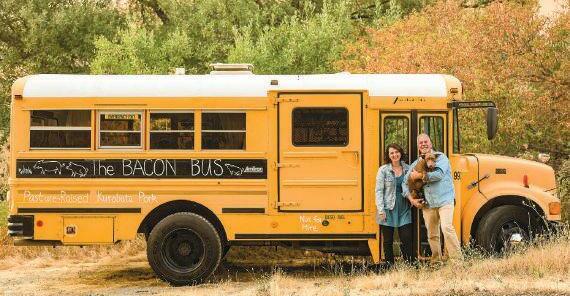
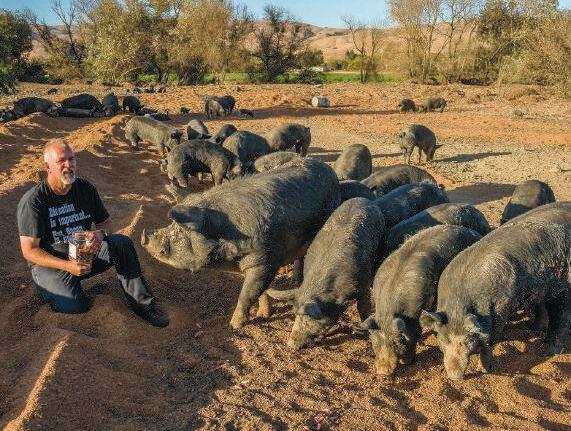
www.ediblemontereybay.com 29
Family farming: top, Sara and Jack Kimmich with their Bacon Bus; below, Jack and the Kimmich’s beloved Berkshire pigs.
With a herd of about 150 covering 30 acres of land, keeping the pigs happy is also a never-ending job.
e family has hosted some travelers who trade labor for accommodation through the volunteer site HelpX, but California Kurobuta has essentially remained a family endeavor. Jack handles the labor and transporting while Sara runs the office, and you’ll meet both of them at any Kurobuta event or Meat Club pickup location. eir three grown children also remain heavily involved.
“We have been amazed at the generosity of our offspring in helping us save our home and in shaping how we make our living,” Jack says. “Each of the three has given their unique abilities to help make this start-up business successful.”
e eldest Kimmich daughter, Anna, runs the website and online marketing from her home in New Jersey. omas, their son and a meatcutter by trade in Grass Valley, does barbecue and helps with special events. Katie, who at 13 delivered the Kimmichs’ first set of piglets, is a college student today and helps however she can.
“Without the input of those three, we wouldn’t be where we are today,” Sara boasts. “We see more of them than we might if we were all merely in volved in our separate careers. And the new generation brings a fresh, hip perspective to our operation.” is is especially helpful as California Kurobuta tackles one of its biggest challenges—expanding its customer base.
When the Kimmichs first began marketing their pork, Jack turned to chefs at restaurants and resorts where he’d already formed relationships through his garden amendment business. ese chefs bought the animals whole, making it unnecessary for the pigs to be processed at USDA facilities, which are in notoriously short supply but are required if an animal is to be sold in parts.
Buying pigs whole is the most economical and sustainable way to purchase pork.
But it’s difficult for the average consumer—and many restaurants—to take on a whole pig, and the Kimmichs knew that for their bu siness to grow, they would need to start selling individual cuts of meat.
So after a few years of searching, the Kimmichs found a USDA facility in Fresno that met their high standards. J&R Natural Meat & Sausage in Paso Robles handles the butchering and packaging.
With packaged cuts of California Kurobuta ready for sale, the California Meat Club was formed.
“Meat Club was our way of making people feel like they’re part of a community that in turn can help spread the word,” Jack says. “e first rule of Meat Club is: Tell everyone about Meat Club.”
Meat Club doesn’t require membership and there are no fees. Instead, it’s a series of regular pop-up appearances by the Kimmichs where customers can meet the family and purchase Kurobuta pork from the “Bacon Bus”—a repurposed school bus from Kentucky that they won in an auction last year.
Meat Club events are all listed conveniently on California Kurobuta’s website; currently there are one to three per week in Monterey, Hollister, San Jose, Los Gatos and Morgan Hill.
Importantly, doing direct sales with consumers rather than using distributors allows the Kimmichs to limit the markup on their prod-

30 edible MONTEREY BAYWINTER 2016
ucts, which are inherently more costly to produce than inferior and less healthful and humanely raised pork.
Prices range from $10–$12 per pound for cuts and roasts. Sausage links (chorizo, spicy Italian, German, Vermont maple, to name a few) are $14 per pound, and bacon runs $8 per package. Bones for broth and pigs feet for dog treats are $5.
Discount cards are also always available, and the Kimmichs plan to start quarterly culls at the farm that they can sell at a reduced price.
“I want everyone to be able to afford good pork!” Jack exclaims “We want this to be affordable so people can truly eat healthy!”

e Kimmichs are also serving their sausages and roast and pulled pork at more and more events. For example, this past 4th of July they were part of the Hollister Independence Rally at Corbin where they partnered with Farmhouse Culture, the Watsonville sauerkraut maker.
“Meeting customers, especially those who share the same ideas about fo od and health, and hearing how eating well has changed their lives—that’s been one of the most rewarding aspects of this endeavor,” Jack reflects. “Watching the herd grow and knowing that they’re healthy and happy, and then being able to share that with a community is amazing.”
“It’s a lot of work, very challenging,” Sara adds. “But you always grow through challenge.”
California Kurobuta Hollister • inf o@californiakurobuta.com www.californiakurobuta.com

SIMPLE KUROBUTA PORK ROAST
Always start with thoroughly thawed meat.
Rub roast with the salt of your choice. Put in a pan with sides (cast iron is our favorite). Add 1 cup of water, fruit juice, wine or even cold coffee
Cook at 210° F for 120 minutes per pound. For example, a 6pound roast would cook for 8 hours. Cook uncovered. If it seems dry, add more liquid. It is ideal to have some liquid left at the end to eat with the meat or make gravy.
Pork is considered safe at 135° F. Use a meat thermometer to determine internal temperature of the roast.
Serve and enjoy! It really only needs salt as seasoning.
www.ediblemontereybay.com 31
Courtesy California Kurobuta in Hollister Pork roast Salt
STILL FARMING
Organic vegetables and “the world’s second oldest profession” go hand in hand on Whiskey Hill
BY DEBORAH LUHRMAN PHOTOGRAPHY BY MICHELLE MAGDALENA
Rowdy cantinas and brothels once lined the stretch of road now called Freedom Boulevard, just outside Watsonville. Gambling, girls and lots of drinking went on there in the 1800s, earning it the name Whiskey Hill—at least until law-and-order types decided a different name might help change the area’s unsavory character. But residents rejected efforts to be tamed and chose the name Freedom, as in freedom to party on.
Up on the ridge towards the ocean, stills were hidden in the forest and used to make whiskey and aguardiente for the saloons below. ey were shut down during Prohibition, but now t he stills are back as part of a multi-faceted project to sell distillation equipment around the world and grow local organic produce for Monterey Bay area markets. Aptly enough, the operation is called Whiskey Hill Farms.
e 14-acre property on Calabasas Road includes five acres of glass greenhouses which once grew roses for Kato Cut Flowers. Renowned alternative fuel activist David
Blume and his partner Jannet Schraer bought the place in 2014 and have spent the past two years working to get both businesses up and running.
What was once a giant packing shed now houses fermentation tanks and 12-foothigh distillation towers where Blume has been practicing what he calls “mankind’s second oldest profession”—making alcohol.
e objective is to manufacture and sell distillation equipment that converts food wastes into alcohol, which can then be used for dozens of purposes from fuel to vodka.
Inside the hothouses, the couple is growing tropical crops like ginger and turmeric, alongside out-of-season produce such as melons and cucumbers—using ingenious low-tech methods that include using water heated in a giant compost pile to keep their plants warm.
ALCOHOL AS FUEL
Part mad scientist and part folksy farmer, David Blume has been a teacher, TV host,
author and organic agriculture consultant for the USDA around the world. Now 60, he has no shortage of provocative opinions and he is brimming with several lifetimes’ worth of ideas for the farm.
“My background is in ecology, which is a science. Environmentalism is a religion, and ecology is a science. It’s a good place to come from to be a farmer,” he says.
His interest in alternative fuels began at San Francisco State University, when a professor challenged him by saying he could run a car on home-brewed beer.
“I went to the library thinking that gasoline was the only fuel in the world and found an enormous stack of books from right after Prohibition about how to use alcohol as fuel, mostly written by contractors for the USDA. I was shocked!” he recalls. en when the oil crisis hit in the 1970s he began making alcohol fuel, also known as ethanol, on a small scale and taught 7,000 other people how to do it.
on p. 36
32 edible MONTEREY BAYWINTER 2016 EDIBLE INNOVATORS
Whiskey Hill reclaimed: page 33, David Blume and partner Jannet Shraer and their turmeric tonic; pages 34–35, clockwise from top right, Blume with one of his stills; the view from Whiskey Hill Farms; Blume’s demonstration of the cleaner-burning nature of alcohol, on left, as compared to gasoline; cattails, which produce 20 times the biofuel per acre as corn; Blume’s tropical crops; center, from left, ginger, turmeric and galangal.
continued

www.ediblemontereybay.com 33




34 edible MONTEREY BAYWINTER 2016





www.ediblemontereybay.com 35
He produced and hosted a 10-part series called Alcohol as Fuel that aired on KQED television and was slated to go national, but was thwarted, he claims, by the oil industry.
“ere is a long history of dirty tricks from big oil—keeping people confused and off-balance about alcohol—going all the way back to Prohibition, which was actually completely funded by Rockefeller to take alcohol off the market as a fuel and had very little to do with drinking,” he says.
Public perceptions that ethanol production—especially from corn in the Midwest— takes valuable farmland out of food production and drives up land prices are unfounded, he claims.
“We almost never say ethanol because oil companies have tarred and feathered that word so thoroughly in the press that people automatically have a reaction to it,” he says.
Blume authored a 600-page book called Alcohol Can Be a Gas!, calling for an ethanol revolution, exploding myths about the food vs. fuel debate and teaching readers how to make the switch.
He says alcohol is a vastly superior fuel, giving off just 1% of the emissions of gasoline—and consequently, engines stay clean and last years longer. In addition to providing energy independence, small-scale alcohol production can convert food waste to energy and power cook stoves.
“Over half the world’s population, or 3 billion people, cook their food over wood, or charcoal or kerosene, and it is a major cause of deforestation,” he says. “Four million women and children are killed each year with lungrelated diseases from breathing wood smoke from indoor cooking fires.”
ECO MOONSHINE

e distillation part of the farm sells smallscale biorefineries capable of using a variety of raw materials to produce alcohol.
e first one was sold in South Africa earlier this year to make alcohol fuel from sorghum, but there are also projects in the works with e Gambia for converting cassava, with Canadian farmers to convert sugar beets and with an Atlanta frozen food plant to turn leftover breading from fish sticks into alcohol fuel.
Blume is working with Del Monte and Dole in the Central Valley to start converting wastes from fruit cocktail processing, which cost the company a lot of money to get rid o f.
While the distillation equipment costs several million dollars, he says the investment can be recouped in about three years with average use.
Closer to home, Blume is in talks with Martinelli’s in Watsonville on a project that would convert apple peels left over after juice and cider pressing into alcohol to power local school buses. e fuel would help the buses run cleaner and last longer.
Of course, the resulting alcohol can also be used for drinking, and Blume is applying for a craft distillery license so he can sell some of his experiments making whiskey from crops like prickly pears, passion fruit and cardoons. “We’re going to have a lot of unusual beverages here,” he predicts.
Over the years Blume has put his ecological principles to work running an organic CSA in Woodside called Our Farm and by consulting as an expert in organic pest management.
36 edible MONTEREY BAYWINTER 2016
“Farmers have way too much work to do, and fighting the bugs is a time consuming effort if you don’t have nature taking care of it for you,” says David Blume.
continued on p. 38
COOKING WITH TURMERIC

Turmeric is having a moment. It’s the “it” ingredient in everything from soups to tonics. But turmeric is appreciated for much more than its peppery taste and the way it turns everything it touches bright yellow.
Traditionally used in Ayurvedic and Chinese medicine, researchers believe that turmeric has more than 100 therapeutic uses.
“It fights inflammation, and it’s one of those h erbal things that actually works,” says David Blume, who is growing 150 tons of turmeric this year in greenhouses at Whiskey Hill Farms in Watsonville. “People with arthritis can actually move their hands again after taking turmeric, ulcers go away, heart disease reduces.”
Local chefs are trying to work turmeric into more of their dishes, both for health and as an exotic flavor ingredient.
“It’s got a great earthy flavor,” says chef and caterer Ella King, who owns Café Ella and Ella’s at the Airport in Watsonville.
She likes to use powdered turmeric in a dry rub—combining it with smoked paprika, cinnamon and salt—and sprinkles it over chicken, pork or even firm-fleshed fish like opah or salmon before cooking. She also dusts fried eggs with turmeric before flipping them over, because it adds flavor and col or to the golden crispy edges.

When using fresh turmeric, she shaves it thinly with a mandolin or a vegetable peeler and adds to oven-roasted vegetables. It can stain fingers and cutting boards, “But it’s not as bad as working with beets,” she adds.
RECIPE: See www.ediblemontereybay.com/recipes for a recipe for Grilled Turmeric Chicken Breast with Raisins from Ella King, chef at Café Ella and Ella’s at the Airport in Watsonville.
www.ediblemontereybay.com 37
One assignment took him to Montana to fight a plague of grasshoppers in the vast northern wheat fields. “I got there and said, ‘You’re so lucky!’ because that’s my answer to everything,” he recalls. “ey thought I must be crazy, but I said ‘No, no, no. is is a massive resource that’s come to your property, and you didn’t even ask for it.’”
Blume asked the farmers to use their bulldozers to build some ponds and fill them with water. en they took weather balloons, spray painted them bright yellow and placed one in the middle of each pond.
“is was the only colorful thing for 40 miles, and the grasshoppers thought it was a flower and came in hordes,” he explains. “ey bounced off the balloons and ended up in the drink.”

So the farmers started scooping tons and tons of dead grasshoppers out of the ponds to spread on their land, gaining enough fertility to last for 50 years. “ey turned a disaster into the biggest fertilizer bonanza ever,” he recalls. “at’s what I do. I look at where there’s a surplus and figure out how to use that surplus.”
TROPICAL CROPS
Out in the greenhouses, many of Blume’s theories are put into practice. For example, plastic hoses run through a giant 25-foot-long compost pile and then o ut into the beds, where they are spaced every four feet.
Water is pumped through the system and, as it passes through the compost, gets heated from the natural decomposition happening in the compost. en in turn, it warms up the soil to tropical temperatures and helps keep the greenhouse toasty.
Other innovations include an anaerobic methane digester to recycle gases given off in the distillation process; an aerobic nitrogen digester for managing runoff; and fish ponds to produce fertilizer.
Using these methods, Whiskey Hill is growing 15 tons of Hawaiian ginger and galangal, as well as a massive crop of 150 tons of turmeric—a rhizome that is commonly used in Indian curries and offers strong antiinflammatory properties.
“It’s extremely popular and, unlike fads, this stuff actually works medically,” says Blume. (See sidebar page 37.)

Other crops currently under cultivation include Persian cucumbers, melons, Osaka purple mustard, sweet Japanese turnips and a wide variety of herbs, including tarragon, dill, basil and cilantro.
In order to optimize space, a high priority is given to exotic vining plants that grow upwards, allowing turmeric and other crops to be cultivated underneath.
Experiments are underway wit h sacha inchi, an Amazonian nut that grows on vines. “It’s quite profitable, very tasty and makes an incredible cooking oil,” he says.
To keep bugs at bay, Blume uses what he affectionately calls “the night crew,” a platoon of frogs, toads and lizards.
“Farmers have way too much work to do, and fighting the bugs is a time consuming effort if you don’t have nature taking care of it for you,” he maintains.
To keep the night crew happy, there are several “frog condominiums” in each greenhouse. e condos are basically a pile of big rocks inside a wire cage, with an algae-filled pond nearby.
Ever the evangelist for his twin passions of regenerative agriculture and “the world’s second oldest profession,” Blume enjoys giving tours to visiting farmers and the general public. During the Corralitos Open Farms Tours la st fall, his eyes twinkled as he ignited two identical bowls of clear liquid sitting side by side in the lab. On the right, the bowl filled with gasoline gave off a big smoky yellow flame, while the bowl on the left filled with alcohol burned cleanly, with a small blue flame and no trace of soot—demonstrating that alcohol is the perfect fuel and reminding us that sometimes we have to look to the past to find our way to a better future.
Luhrman is deputy editor of Edible Monterey Bay and editor of our weekly newsletter. A lifelong journalist, she has reported from around the globe, but now prefers covering our flourishing local food scene and growing her own vegetables in the Santa Cruz Mountains.
Whiskey Hill Farms
371 Calabasas Road, Watsonville 831.722.4455 • www.whiskeyhillfarms.com
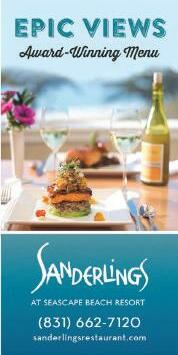
38 edible MONTEREY BAYWINTER 2016
Deborah




www.ediblemontereybay.com 39
EDIBLE ICONS
READY FOR ITS NEXT CHAPTER
A century later, the Highlands is still a pioneer
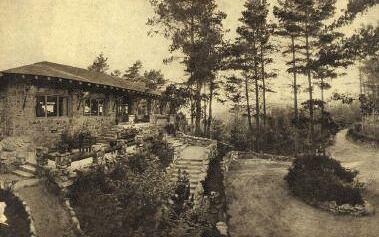

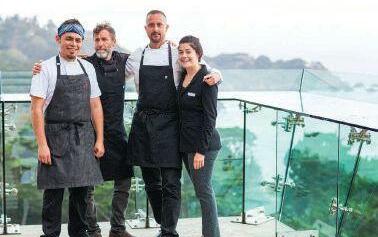 BY CAMILLA M. MANN PHOTOGRAPHY BY MICHELLE MAGDALENA AND CAMILLA M. MANN
BY CAMILLA M. MANN PHOTOGRAPHY BY MICHELLE MAGDALENA AND CAMILLA M. MANN
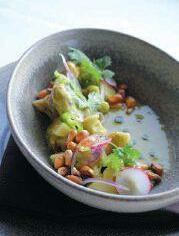
40 edible MONTEREY BAYWINTER 2016
en and now: above, clockwise from lower right, the Highlands in its early day; sous chef Francisco “Pancho” Castellon; Castellon with executive sous chef Alvaro Dalmau and executive chef Chad Minton; a dish from Castellon’s plant-based tasting menu.
One hundred years ago, the Highlands Inn erupted from developer Frank Devendorf’s fierce admiration for the rugged setting. Situated on a pine-dotted cliff with panoramic views of Carmel to the north and Big Sur to the south, Devendorf’s creation showcased the craggy beauty of the area known as Carmel Highlands. A century later, renovations and a new, cutting-edge plant-forward menu reflect the Highlands’ continued appreciation of its history and location as well as a look ahead to where our food scene is moving.
Although just a 10-minute drive from Carmel today, skeptics in Devendorf’s time doubted the appeal of a resort that would be a full day’s ride into the wilderness—by horse and buggy—from the Monterey peninsula. Still, the developer persisted, carefully mapping out with his foreman roads and buildings that would exist in harmony with
Food & Wine series and is now CEO of the Mirabel Hotel & Restaurant Group, referring to what distinguished the event—and to what Mirabel is aiming to do with its own four-year-old GourmetFest. Fink added that at Masters of Food & Wine, the chefs showed an unprecedented camaraderie. “Chefs wanted to work with other chefs—behind the scenes and in the kitchen.”
Local artist and chef Wendy Brodie, who now operates Art of Food Catering and hosts the Art of Food television program, worked both the front and the back of the house at the Masters and recalls the series as summoning “the best of the best,” she says. “e event attracted top winemakers from around the world. And the equally wonderful food was always inventive.”
nature. Locally quarried granite featured prominently throughout the lodge when it opened in 1917, and the stone is still on view in the huge fireplaces that flank its newly remodeled lobby of what is now known as the Hyatt Carmel Highlands.
MAKING A NAME
From the Highlands’ earliest days, its food—including the bounty of fresh produce it could obtain from the immediate region—was an important part of what it offered.
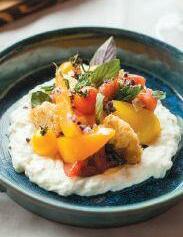
“e dining room is noted for its wonderful ocean views from large windows and its splendid meals, featuring fresh vegetables and fruits,” touts a 1919 brochure.

Over the years, the dining room has indeed hosted countless splendid meals, most notably during the period it held the Masters of Food & Wine, an annual three-day extravaganza that the Highlands staged for 21 years, ending in 2007. (e series is now owned by the Hyatt Corp. and continues, but in locations around the world.)
“It was intimate with a limited number of people,” says former Highlands general manager David Fink, who founded the Masters of
Culinary heavyweights Julia Child, Jacques Pépin, Alain Ducasse, omas Keller and Jean-Louis Palladin all cooked there, and Chad Minton, the Highlands’ current executive chef—who visited the Highlands to cook at the event long before he began working there in 2014—still has their handwritten recipes in his office.
Jerry Regester, now executive chef at the Santa Lucia Preserve, was sous chef under executive chef Cal Stamenov at the Highlands Inn during the time it hosted the Masters of Food & Wine and remembers it being a special time and a magical place.

“e Masters was a huge draw. I remember being in the kitchen at two or three in the morning, prepping for our course, when JeanLouis Palladin walked around the corner. He put his cutting board down next to mine and got to work. en he kept trying to steal my porcini mushrooms. ere I was, this 22-year-old, telling a food icon to keep his hands off my stuff. It was so cool.”
But it wasn’t all glitz and glamour, Regester says. “We just cooked. Whether it was for the Masters, for our regular customers or for the Caltrans crew that was stuck because the roads were washed out, we just cooked.”
www.ediblemontereybay.com 41
Historic photo courtesy Harrison Memorial Library, photo upper right by Camilla Mann. All others p. 40 and 41 by Michelle Magdalena
PREPARING FOR THE FUTURE
Over the last year, the Highlands’ current owner, Florida-based Interval Leisure Group, has been completing what it calls a “rustic-coastal” remodel under the direction of current general manager Mel Bettcher. e aim is to capitalize on its legendary views while—in keeping with the times—make the experience somewhat more casual and accessible.
“Our goal is to have locals think of us as a place to relax and enjoy an evening or a meal—and not just for special occasions,” says food and beverage manager Bastiaan de Winter.
A new heated, 1,200-square-foot glass-walled deck allows diners to eat outside, enjoying unobstructed views of the Pacific while remaining protected from cool coastal weather. Exposed timber and metal straps that were used to reinforce the coastal cliffs are incorporated into the design elements.
Two dramatic makeovers include a reconfiguration of the bar so that all patrons look out over the ocean instead of sitting with their backs to it, and the combining of the upscale Pacific’s Edge restaurant with the casual California Market bistro.
In a departure from Pacific’s Edge’s formerly staid table settings, the new restaurant, California Market at Pacific’s Edge, is replacing its white tablecloths and formal glassware and tableware. New chargers resemble folded leaves; the plates are rustic ceramic versus austere china; and wine goblets have been swapped with hefty tumblers of recycled wine bottles in shades of blue and green.
Expanding on an approach established by previous chefs, when Minton arrived two years ago from Andaz 5th Avenue in New York
City, the Hyatt’s uber-chic flagship boutique hotel, he brought a goal of serving exquisite food made from locally grown or raised—and, when possible, organic—ingredients.
“We have a responsibility to food trends and sensibilities,” Minton says.

Embracing this philosophy of conscious cuisine, he and his accomplished team, which includes executive sous chef Alvaro Dalmau and sous chef Francisco “Pancho” Castellon, are committed to utilizing meats and poultry that are certified organic and naturally raised; cultivating partnerships with local foragers and supporting organic farmers within a 100-mile radius of the property; and purchasing sustainable seafood in compliance with the Monterey Bay Aquarium’s Seafood Watch program.
Minton is an ardent fan of Steinbeck’s books, and de Winter hints there might be some Steinbeck-themed menus coming in the future.
Meantime, pushing the envelope on what sustainable cuisine means, Minton earlier this year offered Castellon, who has been a vegetarian for a decade, the chance to create an innovative new tasting menu in which vegetables could play a starring role.
“ere is such a lack of vegetarian options for diners,” says Castellon. “Often vegetarians only have the choice of a salad or side dishes. I don’t like ordering a salad when I go out to eat. I wanted to offer vegetarians a chance for a full menu.”
e menu is also particularly timely, as more and more trendsetting and sustainability-minded chefs and eaters around the country— particularly those in the millennial generation—come to the conclusion
42 edible MONTEREY BAYWINTER 2016
that truly sustainable eating requires eating less or even no meat or fish, due to the immense burden that meat production puts on water, land and other resources, and to the fact that 90% of global fish stocks have been exploited or depleted entirely.
Of course, imaginative and delectable meat and fish dishes still dominate the restaurant’s main menu, but Castellon’s plant-based tasting menu offers four courses that are just as exciting as those offered to the omnivores, and change with the seasons. And the cost is $40, very reasonable for a tasting menu.
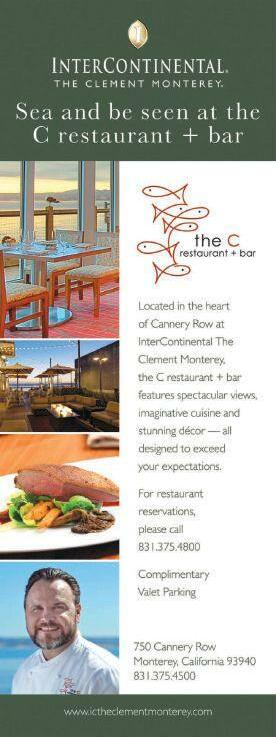
e plant-based menu includes terms such as “ceviche,” “cheese” and “steak”—but those are more conceptual than actual ingredients. e dishes are completely devoid of animal products. Not only is the menu plant based, it also is vegan and gluten free.

Castellon’s first course when I tried it in October was a ceviche made with heirloom cauliflower and shaved radish curls swimming in a pool of spicy tomatillo leche de tigre, the Peruvian term for a citrusbased marinade, dotted with cilantro oil. With the exception of the toasted cancha (Andean chulpe corn) scattered over the ceviche, the dish was completely raw.
e second cour se I tasted was comprised of heirloom beets, avocado, quinoa, grapes, and smoked cashew cheese. It was dusted with wild fennel pollen Castellon foraged himself. Pointing at the canyon, he says, “I gather the fennel and nasturtium flowers on my bike rides over there.”
e third course was a maitake mushroom steak that was foraged, but not by Castellon. “I want to know where he gets the mushrooms, but foragers are so secretive.”
Castellon treats the mushroom like a piece of meat, searing it, and will baste it with coconut oil if the diner is a vegan, or butter if the diner is a vegetarian. He served the mushroom steak with confit potatoes, smoked cashew cream and asparagus, carefully garnished with hand-foraged nasturtium petals and leaves.
His dessert course featured a vegan chocolate almond cheesecake with coconut whipped cream, manjari chocolate (a blend of Criollo and Trinitario cacao beans from Madagascar), and a lightly sweetened wild huckleberry sorbet with huckleberries that the mushroom guy brought in.
Castellon finished it with crunchy Maldon sea salt and a dusting of Espelette pepper that is popular in the Basque region.
“You can get high quality abalone and seafood at nearly every restaurant here. But not many are showcasing our area’s bounty that’s just over there,” Castellon says, gesturing toward the striking landscape in which the Highlands is so deeply rooted.
Camilla M. Mann is a food writer, photographer, adventurer and passionate cook. She blogs at www.culinary-adventures-with-cam.blogspot.com and lives in Seaside.
RECIPE: For chef Minton’s recipe for Butternut Squash, Frangelico and Brown Butter Bisque with Spiced Maple Foam, go to www.ediblemontereybay.com/recipes.
www.ediblemontereybay.com 43
PRESERVATIONIST
HOMEMADE POP-TARTS
Empowering children to cook—even their own “junk food” —is good for everyone
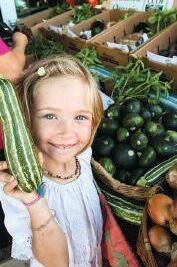 BY JORDAN CHAMPAGNE PHOTOGRAPHY BY MARGAUX GIBBONS AND MICHELLE MAGDALENA
BY JORDAN CHAMPAGNE PHOTOGRAPHY BY MARGAUX GIBBONS AND MICHELLE MAGDALENA
“Eat all the junk food that you want as long as you make it yourself.”
is is food rule number 39 from Michael Pollan’s book Food Rules, and it is a favorite with the kids I know. I use the book as a guide and conversation starter with the youngsters in the cooking workshops I teach as the author has simple and practical advice on what kind of food is healthy to eat.
Because eating is essential, engaging children in cooking comes naturally and can be rewarding for everyone involved. Cooking can seem burdensome as lots of us are busy, but many children—whether our own kids or our nieces, nephews, grandchildren or friends’ kids—would love to share in this task if we would only let them. In my experience, kids are eager to work with “dangerous” knives and interesting kitchen appliances. We simply need to teach them the skills to do so safely. After working with hundreds of kids of all ages, the biggest injury I have seen has been a small cut from a knife or grater.
Taking a cue from Food Rules , one of my favorite culinary projects at the kids’ culinary camps we hold at Happy Girl Kitchen is making Pop-Tarts from scratch. We start by travelling to Lonely Mountain Farm in Corralitos to harvest strawberries and macerate them in sugar and lemon juice right there before we leave. is may seem like an involved process for making a simple pastry, but you can always use jam you’ve made previously with your children. (One of the wonderful benefits of making preserves is having them at your fingertips to turn into other wonderful treats.) We let the strawberries sit overnight to take a break.
e next morning we start the jam cooking while we make our crust. e children have great fun rolling out the dough. We encourage them to stray from the classic rectangular shape and, instead, cut out hearts, circles, ovals and creative shapes.
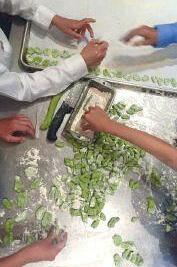
But the real highlight is making the frosting. Once, my young students started to ask about making different colored frostings, and I said, “Yes, let’s try to make it pink with
Kid cooks in action: clockwise from lower right, Champagne’s daughter Jaya Sri picking out her vegetables, small hands preparing pasta and another group tasting what they’ve baked—homemade Pop-Tarts.

44 edible MONTEREY BAYWINTER 2016
Photo at top by Michelle Magdalena, photos at bottom by Margaux Gibbons
hibiscus.” And it all started there. In the end, we made 14 different colors of frosting, all out of natural dyes. A little blackberry jam made purple, cinnamon made brown, green juice made green and lavender, a light pink. We even made bright yellow frosting with powdered turmeric, which ended up tasting much better than anyone thought it would.
What made the project the most fun was the children felt free to experiment and innovate. I find that too many times kids have to follow rules and recipes, but cooking is much more exciting if the cooks are able to influence it. You never know where the project will lead, and the children just might invent something new.
Whether making jam, pickles, dinner or “junk food,” kids really can have a lot of fun in the kitchen. Cooking is a skill they will use for the rest of their lives and a great contribution to the household chores. So teach those kids how to use a chef’s knife safely and get them to work!
Jordan Champagne is the co-owner and founder of Happy Girl Kitchen Co. She has a passion for preserving the local, organic harvest and loves sharing her secrets at the workshops she teaches across the region.

RECIPE: For Jordan Champagne’s recipe for homemade Pop-Tarts, go to www.ediblemontereybay.com/recipes.
GETTING KIDS INTERESTED IN THEIR OWN FOOD

1.Let children pick out their own vegetables. Whether we are at the farmers’ market or the grocery store, I let my kids select any vegetable they want. I have found they enjoy the freedom and are more willing to try a new one if they choose it.
2.Kids like their vegetables crunchy. Raw vegetables put out on the table with a simple dip can really disappear fast! Also, making an easy, crunchy refrigerator pickle with young ones presents opportunities for fun experimentation.
3.Kids like responsibility, especially at a young age. Encourage them to plan one meal a week and provide guidance as needed. ey will like feeling in control and contributing. Set them up for success.

4.Encourage a “no thank you bite.” Oftentimes, just by looking at a new food, people think they will dislike it. I ask that my kids take at least one bite just to try an unfamiliar food before they decide they don’t like it. If they dislike their no thank you bite, they may say “no thank you” when they are offered more.
5.Place a copy of Food Rules by Michael Pollan on the dinner table as it can spawn deep conversation about eating healthfully and sustainably. If children receive these “rules” from someone other than their parents, they may be more willing to hear them. is is especially true of teens and tweens!
6.Teach your children good kitchen safety skills or find a proper mentor to teach them. With the knowhow, they can handle sharp utensils and even immersion blenders and never get hurt.
7.Play with your food! I think the admonishment “don’t play with your food” should be replaced with, perhaps, “respect your food.” We should have fun with it from picking it out to preparing it to eating it. e more enjoyable the process, the more youngsters will want to be involved. (And often, the mess is worth it!)
www.ediblemontereybay.com 45


All of these restaurants emphasize local ingredients, and they also advertise in Edible Monterey Bay! Stop by for a free issue, and tell them that we sent you!

Carried Away
7564 Soquel Drive • 831.685.3926


www.carriedawayfoods.com
A cozy, green-certified, take-out or eat-in café, Carried Away has a menu that changes weekly and features primarily organic, locally sourced ingredients. Owner/chef Tom McNary worked for many years at Chez Panisse, and his dishes reflect the seasons. Soups, salads, entrées and desserts are all made freshly daily. in-crust pizzas available on Tuesday, Friday and Saturday. Open M–F 11am–7pm, Sa 11am–5pm, Su closed.
Sanderlings/Seascape Beach Resort


1 Seascape Resort Drive • 831.662.7120 www.sanderlingsrestaurant.com
With magnificent panoramic views of the ocean and the manicured grounds of Seascape Beach Resort, Sanderlings restaurant is a great choice for a meal any time of day or night. eir wide selection of salads and seafood dishes features locally grown produce and Seafood Watch-approved fish. Santa Cruz County wines are highlighted; weekday Happy Hour on the patio from 4–6pm is an excellent value. Open daily M–F 6am–midnight, Sa–Su 7am–midnight.
BIG SUR
Sierra Mar at Post Ranch Inn

47900 Highway 1 • 831.667.2800 www.postranchinn.com
Executive chef Elizabeth Murray and pastry chef Ben Spungin use exceptional ingredients, many grown on site, to deliver a unique gastronomic take on the Big Sur experience. Dinner features a 4-course prix fixe menu and the 9-course Taste of Big Sur tasting menu; lunch offers 3-course and 5-course options. Choose from almost 3,000 different wines from the Wine Spectator
Dine Local GUIDE


Grand Award winning wine list. Arrive before sunset for breathtaking views from this iconic restaurant’s floor-to-ceiling windows and cliff-side terrace. Open daily for lunch 12:15–2:30pm, dinner 5:30–9pm.
CAPITOLA
East End Gastropub

1501 41st Avenue • 831.475.8010 www.eastendgastropub.com
Some would say that East End Gastropub is the new baby sister to West End Tap & Kitchen, but that reference risks diminishing East End’s grand presence, reworking a very much outdated location and delivering a robust, beer-friendly menu. Chef Geoffrey Hargrave has created dishes that are familiar yet innovative, such as the heirloom potato “risotto” or fried green tomatoes with a buttermilk and polenta crust. e restaurant offers its own brews, along with local rotating taps and a strong wine list. Open Tu–Su 11:30am–10pm.
e

Penny Ice Creamery

820 41st Avenue • 831.204.2523 www.thepennyicecreamery.com Open Su– noon–9pm, F–Sa noon–10pm See e Penny description under Santa Cruz for more.
Shadowbrook
1750 Wharf Road • 831.475.1511
www.shadowbrook-capitola.com

A Santa Cruz County landmark since 1947, the worldfamous Shadowbrook continues to be an overwhelming favorite with locals and visitors alike. Its fine food, extensive wine list and unparalleled setting and ambiance have earned it numerous awards, including Northern California’s “Most Romantic Restaurant” and “Best Date Night Restaurant.” Gift Cards available. Open M–F 5–8:45pm, Sa 4:30–9:45pm, Su 4:30–8:45pm.

www.ediblemontereybay.com 47
Beautiful, delicious pies and other baked goods are the specialty of Sweet Elena’s Bakery and Café in Sand City. See p. 56 for more about Sweet Elena’s.)
CARMEL

400° Gourmet Burgers & Fries

Corner of Mission and Seventh 831.244.0040• www.400degrees.com
Mouthwatering burgers and fries are housemade daily at this casual and fun Carmel eatery. Using locally sourced produce whenever possible, chef-manager Christian Morando has created a build-your-own burger menu to allow for pairings like a Kobe beef patty with sriracha mustard and peppered bacon. Signature sandwiches and salads are also available. Choose from the large selection of artisanal beers and wines; the milkshakes go perfectly with the clean and contemporary ’50s diner vibe of the restaurant. Open Su– 11:30am–8pm, F–Sa 11:30am–8:30pm.
Andre’s Bouchee

Mission Street between Ocean and Seventh avenues 831.626.7880 • www.andresbouchee.com
Chef Benoit Petel aims to use the best seasonal and local ingredi ents in the creative French cuisine he prepares at this warm and elegant restaurant in downtown Carmel. Standouts include Monterey abalone with gnocchi, wild mushrooms and seaweed; a tartine with bone marrow, snails, mushrooms, black radishes and bee balm; and a classic duck confit with lentils. Produce when possible comes from local farms, including Swank Farms and Coke Farm. Open daily 5:30–9:30pm, F–Su noon–2pm.
Aubergine
Monte Verde at Seventh • 831.624.8578 www.auberginecarmel.com
Located within the romantic L’Auberge Carmel, a visit to Aubergine feels like a trip to Europe. Executive chef Justin Cogley was named one of Food & Wine’s best new chefs of 2013 and has been nominated multiple times for a James Beard award and it’s no wonder—he’s an eloquent and imaginative interpreter of fine seasonal ingredients. Pastry chef Yulanda Santos delights with stunning and inventive desserts. Open daily 6–9:30pm.
Basil Seasonal Dining

San Carlos Street between Ocean and Seventh avenues (Paseo Courtyard) 831.626.8226 • www.basilcarmel.com
“Organic, local and seasonal” are not just buzzwords at Basil. is cozy restaurant in the Paseo Courtyard was awarded three stars from the national Green Restaurant Association . General manager/owner Denis Boaro and chef/owner Soerke Peters turn out intensely flavorful dishes and provide a full bar with a great selection of California wines. Many vegan entrées available. Heated, dog-friendly outdoor seating. Open daily for lunch and dinner from 11:30am, Su brunch 11am–3pm.

California Market at Pacific’s Edge

Hyatt Carmel Highlands 120Highlands Drive 831.620.1234• www.pacificsedge.com
Enjoy sustainable, locally sourced farm-to-table fare prepared by executive chef Chad Minton’s team while dining on the outdoor deck overlooking unobstructed views of the Pacific Ocean. Dine indoors next to the expansive windows and gaze at the rugged beauty of the Big Sur coastline. In addition to the à la carte menus, they offer exciting daily specials, craft cocktails and the very best California wines. Open for breakfast, lunch and dinner seven days a week.
48 edible MONTEREY BAYWINTER 2016
Cantinetta Luca

Dolores street and Ocean avenue
831.625.6500 • www.cantinettaluca.com
Prepared in the Tuscan tradition, using the freshest and simplest ingredients sourced locally or imported from Italy, this authentic Italian eatery serves housemade breads, pastas and sauces, hand-cut premium meats and antipasti with chef Christopher Vacca’s artisanal salume. Guests are served in an atmosphere of warm tones and dark woods, which invites lingering over a second glass of wine or another bite of tiramisu, apple crostata or cheese. Open Su– 11:30am–9pm, F–Sa 11:30am–10pm.
Carmel Belle
Doud Craft Studios
San Carlos street at Ocean avenue 831.624.1600 • www.carmelbelle.com
is bright, airy restaurant is a favorite gathering place for anyone looking for a casual atmosphere and a stellar breakfast, lunch or dinner. e chefs here source only the best local and organic ingredients for their seasonally driven menu. Sign up online to receive Belle’s pop-up calendar and to hear about its special events. Enjoy your meal next to the fire pit or take advantage of the curbside pickup service to take it home. Open W–Su 8am–8pm, M–Tu 8am– 5pm.

Earthbound Farm’s Farm Stand

Organic Kitchen
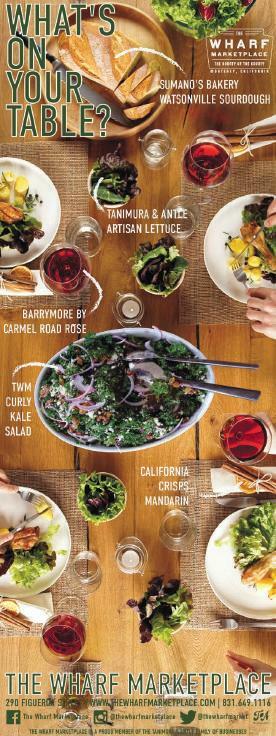
7250 Carmel Valley Road • 831.625.6219 www.ebfarm.com/ourstory
At its Carmel Valley Farm Stand, Earthbound Farm’s certified organic kitchen delights with housemade soups, sandwiches, baked goods and a vibrant salad bar. Experience picturesque Carmel Valley as you stroll through Earthbound’s organic gardens and learn about its pioneering local heritage and commitment to organic integrity. Food is available for take-away or a relaxing afternoon at tables in the gardens. Groceries also are available for replenishing your pantry. Watch Facebook for special events and classes! Open M–Sa 8am–6:30pm, Su 9am–5:30pm.
Il Grillo
Mission Street between Fourth and Fifth avenues 831.238.9608 • www.ilgrillocarmel.com

e intent behind this sister restaurant to Carmel’s popular La Balena is to create a more casual spot where diners can gather for a glass of wine, simple pastas and small plates. Enjoy a housemade Italian cookie or dessert after your meal, or put in an order to bring some treats home. Prices are also lower than at La Balena, but the same chef is creating the dishes, so expect impeccable sourcing and delicious results. Garden seating available. Open M–F 11:30am–9pm, Sa 5–9pm.
La Balena

Junipero street between Fifth and Sixth avenues 831.250.6295 • www.labalenacarmel.com
Winner of EMB’s 2014 Local Heroes award for Best Chef/Best Restaurant, La Balena has a seasonal menu that changes daily but always expresses an inventive take on the rustic food of a Tuscan trattoria. e outstanding culinary team sources ingredients from local organic farms and prepares the restaurant’s pastas and lowcooked meats from scratch daily. Owners Anna and Emanuele Bartolini have created an excellent Italian wine list and a warm, inviting atmosphere, complete with back garden seating. Open Tu–Su 5–10pm.
www.ediblemontereybay.com 49
CARMEL VALLEY
Cachagua General Store/Lokal
13750Center Street
831.659.5886(Lokal)/831.659.1857 (CGS) www.lokalcarmel.com


Father and son Michael and Brendan Jones are now under one roof with the relocation of Michael’s legendary Monday-night pop-up, the Cachagua General Store, to Brendan’s Lokal restaurant in Carmel Valley Village. e two restaurants will continue to operate independently, both of them emphasizing local and organic ingredients but each remaining the exuberantly creative and distinct foodie oasis it has become known for. CGS is open 10–12:30 on Sundays and 6pm–Midnight on Mondays. Lokal’s hours are 10–2:30 and 6pm–closing –Su.
Lucia Restaurant & Bar

Bernardus Lodge & Spa
415W. Carmel Valley Road • 831.658.3400
www.bernarduslodge.com/wine-cuisine
Where once there were walls, glass panels now can be folded back to bring the outside into the new Lucia Restaurant & Bar. Named for the Santa Lucia mountain range and wine appellation that beckons to the south of the lodge, the expansive restaurant replaces what once was Wicket’s Bistro and Marinus. Renowned chef Cal Stamenov is still in the kitchen, serving both his signature tasting menu and dishes à la carte. Wine list is equally notable. Open daily 7am–2pm and 5–10pm.
ROUX

6Pilot Road • 831.659.5020 • www.rouxcarmel.com
Chef Fabrice Roux opened his namesake restaurant ROUX in Carmel Valley in December, creating a charming European atmosphere with a romantic, contemporary interior and sun-drenched patio. e popularity of his small plates and paella just might be surpassed by his housemade French beignets with local fresh-fruit filling, served with Illy coffee as early as 7:30am for those who stop in. Monthly wine dinners and extensive wine list. Open daily 11:30am–10pm, Sa–Su 10am–3pm for brunch.
Trailside Café and Beer Garden
3Del Fino Place • 831.298.7453 www.trailsidecafecv.com


ose needing to refuel after a day on the trail can head to Trailside Café for home-cooked meals in Carmel Valley. Beer lovers get to choose from 16 on t ap, and sports fans can watch games on the HDTVs. Locals are treated to specials on Mondays and Tuesdays. On the weekends enjoy live music in the dining room. Check out the calendar on its website for more details. Dogs are welcomed on the patio. Open daily 8am–9pm.
DAVENPORT
Whale City Bakery

490Highway 1 • 831.423.9009 www.whalecitybakery.com
Davenport’s artistic charm and oceanside location make it hard not to slow when you pass through on Highway 1. ose in the know always stop at the historic Whale City Bakery. e bakery tempts with housemade breads, pastries, muffins and pies—and that’s only the beginning! Whale City also offers a full restaurant that serves up comfort classics and other hearty dishes. e bar and live music every ursday attract a loyal local following. Open daily 6:30am–8pm.
50 edible MONTEREY BAYWINTER 2016
e Cremer House
6256 Highway 9 • 831.335.3976 www.cremerhouse.com
Housed in the oldest building in Felton, e Cremer House showcases progressive, handmade food and drink with a nod to its historic mountain surroundings. is collaborative restaurant project between the Felton New Leaf Market and Santa Cruz Mountain Brewing has filled a niche in the San Lorenzo Valley, bringing organic craft beer, cider and wine on tap, and artisan, housemade breads and “pantry” products to this restored and revered property. Open Su– 11:30am–9pm, F–Sa 11:30am–10pm.
HOLLISTER
Grillin & Chillin Alehouse and Brewery

401 McCray Street, Suite B24 • 831.637.2337

Grillin & Chillin’s downtown location with an on-site brewery is your go-to spot for a burger and beer. With 40 craft beers on tap and just as many in bottles, there’s something for everyone. A favorite spot among bikers and other Hollister locals, the alehouse has a friendly and knowledgeable staff that can help you pick a pint from the long list of brews. Open Su–W noon–10pm, –Sa noon–11pm.
Grillin & Chillin Roadhouse

3650 San Juan Road • 831.636.1010 www.relaxgrillinchillin.com
Grillin & Chillin’s Roadhouse location is your stop for steaks, burgers, craft beer, and whiskey. With 30 beers on tap (including many locals brews), 100 more in bottles, and a long list of small batch bourbon and whiskies, there are plenty of options to help wash down your fish tacos, Cowboy Burger, or 16-ounce bone-in ribeye named the “Tomahawk.” Catch the game on one of the 5 TVs, or relax on the covered patio. Open Su– 11:30am–9pm, F–Sa 11:30am–10pm.
HOPE VALLEY
Sorensen’s Country Café

14255 Highway 88 800.423.9949 • www.sorensensresort.com

e next time your travels take you to Lake Tahoe, remember the adorable Sorensen’s Resort’s full-service restaurant. Enjoy specialties such as Mary’s natural chicken with a gremolata topping, fresh and wild fish, New York steak, garden-fresh salads, housemade bread pudding and a wonderful berry cobbler. Enjoy Eggs Benedict on weekends. Accompany your meal with a fine wine or specialty beer. Open for breakfast M–F 7:30–11am and Sa–Su 7:30am–noon, lunch daily from 11am–4pm, dinner 5–8:30 pm daily.
MONTEREY
e
C restaurant + bar
InterContinental e Clement Monterey 750 Cannery Row • 831.375.4500


www.ictheclementmonterey.com
Step into e C restaurant + bar and the bustle of Cannery Row will seem like a world away. Elegant yet relaxed, e C offers stunning ocean views from its floor-to-ceiling windows and oceanside deck; chef Matt Bolton provides equally gorgeous food, imaginatively
www.ediblemontereybay.com 51
FELTON
prepared from sustainably sourced seafood, meats and produce. Creative cocktails include a design-your-own Bloody Mary. Open 6:30am–10pm daily. Happy hour 4–7pm Su-.
Cannery
Row Brewing Co.
95Prescott Avenue • 831.643.2722 www.canneryrowbrewingcompany.com

At CRBC, guests are greeted by a keg room chilling the 75 beers on tap. At this mecca of comfort food, executive chef Justin Robarge’s newest addition is a popular late-night breakfast menu available on Fridays and Saturdays. For lunch, dinner and everything in between, enjoy a CRBC Burger, Short-Rib Grilled Cheese Sandwich or Hickory-Smoked Pork Chop, and wash it down with a Rock Star Beer or Small Batch Bourbon. Open M–Sa 11am, Su 9:30am.
Jacks Restaurant & Lounge

2Portola Plaza 831.649.2698• www.jacksrestaurantlounge.com
Perfect for any occasion, visit Jacks for breakfast, drinks or dinner, or plan a private event on the pet-friendly heated patio or indoors in the fireside dining room. e restaurant features a breakfast buffet with made-to-order omelets and bottomless mimosas, locally grown produce, certified Angus beef and fresh seafood for dinner. Jacks Lounge features daily Happy Hour from 4–6pm with small bites, an award-winning wine list and barrel-aged cocktails. Open for breakfast M–F 6–11am, Sa–Su 6am–noon; dinner daily 5–10pm.
Peter B’s Brewpub
2Portola Plaza 831.649.2699• www.peterbsbrewpub.com Experience Monterey’s original craft brewery, Peter B’s Brewpub, located behind the Portola Hotel & Spa. Enjoy great food and award-winning handcrafted beers. Watch your favorite game on one of 18 HDTVs or enjoy the pet-friendly heated patio with fire pits. Peter B’s is open daily with nightly Happy Hour from 4–6:30pm. Open Su 9:30am–11pm, M– 11am–11pm, F–Sa 11–12am.
Restaurant 1833

500Hartnell Street • 831.643.1833 www.restaurant1833.com



Watch for exciting new developments at Restaurant 1833 as new executive chef Mikey Adams takes over the kitchen at this historic, famously haunted adobe. Adams brings his experience in some of San Francisco’s most noted restaurants (Central Kitchen and One Market) to unveil an approachable, yet technique-driven menu. Complementing the food program, lead bartender Josh Perry helms the national award-winning beverage program where guests can leisurely enjoy a cocktail at the onyx bar or outside fire pits. Kitchen open Su– 5:30–9pm, F–Sa 5:30–10pm.
Stone Creek Kitchen

465Canyon del Rey Boulevard • 831.393.1042 www.stonecreekkitchen.com
A glass-walled kitchen in the middle of a spacious cookware shop turns out imaginative Mediterranean deli treats and sweets to take away or eat under the market umbrellas outside. Petite baguette sandwiches—like grilled chicken, artichoke hearts and Boursin cheese— are little works of art. Don’t miss the pistachio/cherry chocolate bark or the paella Fridays. Open M–F 10am–7pm, Sa 10am–4pm, Su closed except during November and December.
52 edible MONTEREY BAYWINTER 2016
TusCA Ristorante

Hyatt Regency Monterey Hotel & Spa

1 Old Golf Course Road • 831.657.6675 www.tusca.com/hpr/tusca/en/monterey.html
Blending the beauty and bounty of Tuscany and California, and inspired by the hearty appetite and abundance of southern Italy, TusCA serves up seasonally sourced menus made from fresh, local produce, meats and fish. TusCA chef Steve Johnson delights diners with meals both intriguing and indulgent, particularly those baked in his wood-burning oven or served with the housemade pastas. Open daily for breakfast and lunch 6:30am–1:30pm, dinner 6–9pm Tu-Sa.
e Wharf Marketplace
290 Figueroa Street at Wharf No. 2 and Del Monte avenue 831.649.1116 • www.thewharfmarketplace.com


e Wharf Marketplace is Monterey’s newly remodeled, go-to fresh, local market with free 24-minute parking which features the best-grown Salinas Valley lettuces and vegetables, artisanal cheeses, wines and draft beer. e Café & Grab-n-Go selections are designed to satisfy your cravings for every meal. Catering made easy for any staff breakfast or lunch and ready-to-take home dinners are sure to delight. Comfortable indoor/outdoor seating available. Open daily 5:30am–7pm; Taste It ursdays offer complimentary wines and beer tasting with one-bite wonders 4:30–6:30pm.
MOSS LANDING
e

Haute Enchilada
7902 Moss Landing Road • 831.633.5843 www.hauteenchilada.com
Gourmet Latin fusion dishes await those who venture off Highway 1 and into this fanciful restaurant with its large gallery out back that also serves as a venue for entertainment and private events. Fiesta-colored walls in the restaurant are adorned with enormous gold leaf paintings. Try dishes like Peruvian Ceviche, Squash Blossom Empanadas or the popular Pescado Cubano— line-caught red snapper in a pistachio/pumpernickel crust served with tomatillo avocado sauce. Ingredients are all natural, organic as much as possible. Open daily 11am. Last seating at 8pm.
PACIFIC GROVE
Happy Girl Kitchen Co.

173 Central Avenue • 831.373.4475 www.happygirlkitchen.com

e menu changes daily at Happy Girl’s airy and bright Pacific Grove café, but the food is always delicious, organic and reasonably priced. e sandwich of the day is $6.50, and a bowl of the soup of the day is $6. To drink, you’ll find kombucha on tap and freshly roasted Four Barrel coffee brewed to perfection. Homemade baked goods include a daily scone, cookies and turnovers. Open daily 7:30am–3pm.
Jeninni
Kitchen + Wine Bar
542 Lighthouse Avenue • 831.920.2662 www.jeninni.com
Inspired by flavors of the Mediterranean, Jeninni Kitchen + Wine Bar’s rich and decadent cuisine takes you on a journey from Morocco and Spain to the Levant, birthplace of owner and sommelier, amin Saleh. Don’t miss chef Matthew Zimny’s crispy octopus, lamb burger with signature eggplant fries and occasional
53
www.ediblemontereybay.com
paella nights and other special events. Open Su– 4–9pm, F–Sa 4–10pm. Happy Hour—”sips and snacks”—4–6pm every day. Closed W.
Passionfish

701Lighthouse Avenue • 831.655.3311 www.passionfish.net
If you’re looking for a restaurant with playful, spectacular food and a scrupulous commitment to sustainability, this green-certified restaurant is hard to rival. e elegant dining room is celebratory yet relaxed, and the award-winning wine list features many sustainable names and is priced at retail. Chef Ted Walter’s menu is ever changing with the seasons, but always includes delicious organic local produce, inventive slow-cooked meats and an array of sustainable seafood choices. Open daily 5pm.
Point Pinos Grill

79Asilomar Boulevard • 831.648.5774 www.ptpinosgrill.com



With sweeping views of the coast and a relaxed clubhouse vibe, this scenic spot has blossomed under the direction of executive chef Dory Ford. For breakfast, choose from huevos rancheros, chicken fried steak and an array of tasty omelets. For lunch through dinner, enjoy dishes like Ale-Steamed Mussels and Crispy Fried Dry Rubbed Jerk Chicken Wings paired with craft beers, local wines or a house specialty cocktail. Open M–F 7:30am–8pm, Sa 7am–8pm, Su 7am–6pm. Happy Hour M–F 4–6pm.
PEBBLE BEACH
e Bench
e Lodge at Pebble Beach, 1700 17-Mile Drive 866.543.9318• www.pebblebeach.com/dining
Overlooking the 18th hole at Pebble Beach Golf Links, e Bench at e Lodge at Pebble Beach delivers an eclectic menu inspired by international styles and methods, which uses the innovative technique of wood roasting and open-flame cooking. You can also enjoy one-of-a-kind craft cocktails, as well as an array of draft beers and wines by the glass. Open daily 11am–10pm.
Gallery Cafe
e Lodge at Pebble Beach, 1700 17-Mile Drive 866.543.9318• www.pebblebeach.com/dining
Overlooking the first tee of Pebble Beach Golf Links, Gallery Cafe offers a wide selection of breakfast choices, from light smoothies to omelets and pancakes. For a casual lunch, try the excellent burgers or choose from a delicious selection of artisan sandwiches, plus the best milkshakes this side of the 1950s. Open daily 6am–2pm.
Pèppoli at Pebble Beach

e Inn at Spanish Bay, 2700 17-Mile Drive 866.543.9318• www.pebblebeach.com/dining
At Pèppoli, the scents of Italian herbs and spices fill the air, and the décor transports you to a cozy Tuscan villa. e menu is big and bold, ripe with traditional pastas, seafood and meats. e extraordinary wine list is matched by equally impressive dishes, including delicious desserts, all with stunning views of Spanish Bay. Open daily 6pm–10pm.

54 edible MONTEREY BAYWINTER 2016
Porter’s in the Forest
3200 Lopez Road • 831.622.8237 www.portersintheforest.com


A restaurant on a golf course, not a golf course restaurant. Chef Johnny De Vivo and his team have created a destination dining experience that has quickly become Yelp’s No. 1 rated restaurant in Pebble Beach. Worried about driving on 17-Mile Drive? ey will reimburse you up to $20 if you take UBER transportation, which should cover round trip from almost anywhere on the peninsula. Open daily for breakfast and lunch and W–Su for dinner.

Roy’s at Pebble Beach
e Inn at Spanish Bay, 2700 17-Mile Drive 866.543.9318 • www.pebblebeach.com/dining
It’s all about big flavors and the gorgeous ocean view at Roy’s at Pebble Beach. Fresh seafood is front and center, where sushi, sashimi and blackened rare Ahi tuna are prepared to perfection, but many exciting meat dishes and island salads are also featured on the extensive Hawaiian-fusion menu. Add a dynamic wine list, exceptional desserts and an energetic environment, and you have one impressive dining experience, all overlooking Spanish Bay. Open daily for breakfast 6:30–11am, lunch 11:30am–5pm, dinner 5:30–10pm.
Stave Wine Cellar at Spanish Bay
e Inn at Spanish Bay, 2700 17-Mile Drive 866.543.9318 • www.pebblebeach.com/dining
A combined wine lounge and retail shop, Stave Wine Cellar is a luxurious yet casual space that is ideal for special wine dinners or gathering with friends and colleagues. You can pair varietals by the glass with a menu of cheese and charcuterie plates. In addition to nearly 30 wines and eight craft beers by the glass, Stave has more than 200 wines for purchase by the bottle, including a wide selection of coveted bottles. A knowledgeable staff, including certified sommeliers are on hand. Open Tu–Sa 2–10pm, Su–M 2–7pm.
STICKS

e Inn at Spanish Bay, 2700 17-Mile Drive 866.543.9318 • www.pebblebeach.com/dining
STICKS is the perfect place for home-style comfort food in a lively sports bar atmosphere. Savor a hearty meal, a cold draft beer or one of the many tasty appetizers while enjoying sports on big flat-panel TVs. Outside on the patio, enjoy seating next to our fire pits while soaking in gorgeous views of e Links at Spanish Bay and the Pacific Ocean. Ask about our nightly Bagpiper Specials, such as Bacon-Wrapped Meatloaf, Southern Fried Chicken ‘n’ Waffles or Juicy Prime Rib. Open daily 6am–9pm.
Stillwater Bar & Grill



e Lodge at Pebble Beach, 1700 17-Mile Drive 866.543.9318 • www.pebblebeach.com/dining
Stillwater Bar & Grill prides itself in offering the freshest and most flavorful in sustainable seafood and organic produce. Whether it’s breakfast, lunch or dinner—or Stillwater’s famous Sunday Brunch—the menus are sure to delight. Shellfish lovers will marvel at the bountiful seafood tank, while those who prefer turf to surf can choose from a variety of meaty options. Each of these delectable feasts is enhanced by fantastic views of Carmel Bay and the 18th hole of Pebble Beach Golf Links. Open daily 7:30am–10pm.
www.ediblemontereybay.com 55
e Tap Room

e Lodge at Pebble Beach, 1700 17-Mile Drive 866.543.9318• www.pebblebeach.com/dining e Tap Room is more than a legendary 19th hole with an outstanding selection of draft and bottled beers, vintage wines and top quality spirits. It’s also a world-class steakhouse serving up hearty all-American fare, from burgers to prime rib to filet mignon. Renowned for its extensive collection of prized golf memorabilia, e Tap Room is a comfortable and inviting place for watching televised sporting events or recounting your successes on the courses of Pebble Beach. Open daily 11–12am.
SAN JUAN BAUTISTA
Vertigo Coffee Roasters

81Fourth Street • 831.623.9533 www.vertigocoffee.com
Artisanal coffee roasted on site as well as wood-fired pizzas, freshly made soups, salads, sandwiches, breakfast burritos plus pan dulces from El Nopal bakery in Hollister have made Vertigo a locals’ favorite as well as a great find for visitors en route to the San Juan Mission, Pinnacles or other area attractions . Owners Dmitri and Kitty Fridman have recently added regional craft beer, served on a 21-and- over beer garden, out back. Open Tu–F 7am–7pm, Sa–Su 8am–7pm. Closed M.
SAND CITY
Sweet Elena’s Bakery and Café
465Olympia Avenue, Suite D • 831.393.2063 www.sweetelenas.com
Whether for a delicious breakfast, lunch or baked goods to go, this warm café provides a welcome respite from the big-box stores that surround it. Baker-owner Elena Salsedo-Steele uses fine local ingredients in all her quiches, galettes and sweets. Some are made from family recipes; all are from scratch. Her granola has a cult following. Sweet Elena’s is also a community anchor—it regularly hosts book signings, art shows and other cultural and holiday events. Open M–F 8am–5pm, Sa 9am–3pm.

SANTA CRUZ
Assembly
1108Pacific Avenue • 831.824.6100


www.assembly.restaurant is full-service restaurant from Penny Ice Creamery founders Kendra Baker and Zach Davis offers rustic California cuisine based on local, seasonal and sustainably sourced ingredients. Watch for new chef Jessica Yarr to make her own mark. e restaurant’s woodmetal-stone décor radiates from a long community table that anchors the center of the dining room, which is filled with natural light in daytime and bathed in the soft glow of copper accents at night. Open for lunch weekdays 11:30am, dinner W–M until late, brunch 10am Sa–Su, closed Tu.

Charlie Hong Kong
1141Soquel Avenue • 831.426.5664
www.charliehongkong.com
Charlie Hong Kong has been providing the Santa Cruz community with healthy, sustainable, affordable and high-quality food since 1998. e colorful, casual eatery’s delicious fusion of Southeast Asian influences and the Central Coast’s local organic produce has made it a neighborhood favorite. Its slogan is “love your body, eat organic,” and its cuisine is proof that fast food can

56 edible MONTEREY BAYWINTER 2016
be good for you. All dishes may be ordered vegan or with meat or fish. Open daily 11am–11pm.

e Crow’s Nest
2218 E. Cliff Drive • 831.476.4560

www.crowsnest-santacruz.com

A perfect spot to enjoy lunch or catch a sunset over the harbor, the nautical-themed Crow’s Nest is a Santa Cruz institution that never goes out of style. ere’s always something happening, from free seasonal ursday night beach parties to comedy nights and happy hours. Famous for its salad bar and house-smoked salmon, e Crow’s Nest is a member of Seafood Watch and is a certified green business. Open daily for breakfast 7:30–11:30am; lunch M–F 11:30am–2:30pm and Sa–Su 11:30am–3pm; dinner M–F 5pm, Sa–Su 4:30pm.
Earthbelly
381 Soquel Avenue • 831.621.2248


www.eatearthbelly.com

e fine dining veterans behind this food stop are serving sophisticated yet affordable organic, non-GMO food for the 99%. No-fuss counter service doesn’t detract from the open, airy and surprisingly elegant space and the deliciously detailed menu. Enjoy soups, salads, burgers, pizzas, and baked goods made with produce from local farms in the restaurant or on the go. Dietary restrictions are accommodated. Delivery is available. Open M, W, 11am–9pm, F–Su 11am–10pm. Closed Tu.
Food Lounge
1001 Center Street • info@scfoodlounge.com www.scfoodlounge.com

is airy, contemporary space with a large courtyard is the creative staging ground for exciting pop-up dinners and community events. Monday through Saturday, the fun gets started at 11am with the Pantry Artisan Market, a local artisan food marketplace. Happy hour at the Food Lounge bar runs M–F, 4–6pm and features local beer, wine, cider and small batch craft spirits. For a full list of events and hours see calendar at www.scfoodlounge.com.
Laílí
101B Cooper Street • 831.423.4545 www.lailirestaurant.com

Exotic flavors of the Silk Road are served in a stylish dining room decorated in eggplant and pistachio colors and on a hidden candlelit patio. Locals rave about Laílí’s homemade naan served warm from the oven with a selection of Mediterranean dips. ere is a wide variety of deliciously spiced vegetable dishes, organic whenever possible, and all meats are hormone free and free range. Open daily for lunch 11:30am–2:30pm, dinner 5–9:30pm.
La Posta
538 Seabright Avenue • 831.457.2782 www.lapostarestaurant.com
A cozy neighborhood bistro not far from the Santa Cruz yacht harbor, La Posta chef K atherine Stern prepares Northern Italian cuisine using local ingredients—some foraged and some grown on nearby organic farms. Charcuterie is house cured, pasta, bread, and gelati are made in-house, while the balance of the menu reflects whatever produce is freshest right now. A sister restaurant of Soif Restaurant and Wine Bar, La Posta also offers a great selection of wines. Open Tu– 5–9pm, F–Sa 5–9:30pm, Su 5–8:30pm, M closed.

www.ediblemontereybay.com 57
e Penny Ice Creamery
913Cedar Street • 831.204.2523

www.thepennyicecreamery.com
Lines out the front door of its converted Spanish bungalow are evidence of Penny’s popularity. All ice cream, including bases, is made from scratch on the premises using local organic ingredients when possible. Dozens of exotic flavors rotate seasonally, but two favorites are bourbon bacon chocolate and strawberry pink peppercorn. Open daily noon–11pm.
Downtown – Kiosk 1520 Pacific Avenue, Ste. K2 Open Su– noon–6pm, F–Sa noon–9pm See also e Penny under Capitola.


e Picnic Basket
125Beach Street • 831.427.9946 www.facebook.com/thepicnicbasketsc

Across the street from the main beach, owners of e Penny Ice Creamery have opened an alternative to boardwalk fast food. Sandwiches, organic salads, coffee and beer, all from local food artisans, and of course Penny’s popular ice cream, are all on offer to eat in or outside with your feet in the sand. Open daily 7am–4pm.
Pour Taproom


110Cooper Street, Suite B • 831.535.7007 www.pourtaproom.com
Browse the 70 craft beers and several keg wines on tap then pour your own, paying by the ounce. Lots of local favorites on tap, along with a beer-friendly menu of cured meats, cheeses, pickles, fish tacos and nitrite-free “haut daugs” on Bavarian pretzel buns. Seasonal daily specials like beer-braised short ribs, beef stew and curries will keep you warm all winter long. Open daily 11am–11pm. Closed Su.
Rosie McCann’s
1220Pacific Avenue • 831.426.9930 www.rosiemccanns.com

No typical Irish pub, Rosie’s emphasizes organic, local ingredients in its traditional Irish dishes like lamb stew, shepherd’s pie, corned beef hash and fish and chips, as well as its California specialties such as grassfed burgers, coriander wild salmon, salads and fish tacos. Expect dozens of beers on tap—including local selections. All desserts are made in house, so save room for the Guinness-Ghirardelli chocolate cake. Open M–F for lunch 11:30am–4pm; dinner 4–10pm. Open Sa–Sun for brunch 9:30am–2pm; dinner 2–10pm.
Soif Restaurant and Wine Bar

105Walnut Avenue 831.423.2020• www.soifwine.com
Inspired by the offerings from local farmers and provisioners, chef Mark Denham’s cuisine shows California flair, with seasonal dishes like autumn endive salad with pear, steamed clams with housemade linguica, potatoes and kale, and a great burger! A cozy, new bar now offers cocktails in addition to the best w ine selection in town. e bottle shop next door provides a world-class selection of wines, and a welcoming seating area for sampling them. Raw oysters and live jazz every Monday. Open Su– 5–9pm, F–Sa 5–10pm. Wine bar opens noon Tu–Sa, 5pm Su–M.
58 edible MONTEREY BAYWINTER 2016
Süda

3910 Portola Drive • 831.600.7068 www.eatsuda.com
Every element of this tasteful space offers the diner with choice and comfort, from the diverse menu with vegan, gluten-free and full-fledged carnivore options to the high caliber beverage program to a variety of intimate booths, bar stools and communal seating. ere’s even a private room in the back, perfect for making a special occasion even more so. Open Su–W 11:30am–9pm, –Sa 11:30am–10pm. Open M 5pm.
Ulterior

10 Pearl Street • 831.295.3100 www.ulteriorsc.com e enticing, almost secret nature of an upstairs restaurant never fails. At Ulterior, the latest venture of the former pop-up team of chef Zachary Mazi and Tighe Melville of LionFish SupperClub, what awaits you at the top of those steep stairs from parent business Motiv down below is an alluring combination of seasonal, innovative dishes, crafty cocktails and a hip atmosphere. is Ulterior nest is also one of the rare places in Santa Cruz where you can get a high quality, late-night nibble. Open Tu–Su 5–10pm-ish.
West End Tap & Kitchen

334D Ingalls Street • 831.471.8115 www.westendtap.com
At West End, perfect for any parent who is looking for a happy hour to satisfy the whole family, adults and kids alike can’t get enough of the duck fat popcorn, fried calamari and flatbread pizzas. A diverse, season-driven menu with offerings like roasted broccolini with habanero vinaigrette, and an even longer list of craft beer, cider and wine options make West End a Westside staple. e outdoor patio is perfect for people watching amidst the bustling Swift Street Courtyard. Op en daily 11:30am–10pm.
SEASIDE
Gusto
1901 Fremont Boulevard 831.899.5825 • www.gustopizzeriapasta.com

Gusto owner Denis Boaro, a partner in Carmel’s Basil Seasonal Dining and a native of Northern Italy, named the restaurant for the Italian word for taste and his enthusiasm for delivering delicious rustic Italian food and great service can be seen in the happy faces of his diners. e bright red-tiled, wood-fired oven just inside the entrance both sets the restaurant’s festive tone and produces terrific pizzas. Pastas are from Sand City’s Bigoli pasta and are made from organic flours. Open daily 11:30am–2:30pm and 4:30–9pm.
SOQUEL
Surf City Sandwich
4101 Soquel Drive • 831.346.6952 www.surfcitysandwich.com




It makes perfect sense in a town so rich in surf lore that a surfer would be the driving force behind a popular local haunt and similarly storied classic: the sandwich. Owner and chef Paul Figliomeni’s motto, “Go Fresh or Go Home,” is an indicator that anything you order here will be made with good ingredients and by hand. row in some vintage surf goods, homemade potato chips and local beer on tap and you’ll never actually make it down to the beach. Open M–Sa 10:30am–7pm, Su 10:30am–5pm.

www.ediblemontereybay.com 59



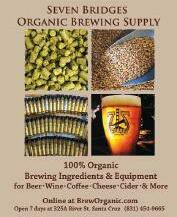
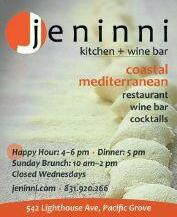



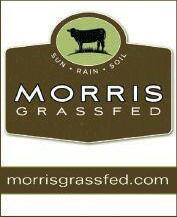
60 edible MONTEREY BAYWINTER 2016
BAY MARKETPLACE • MONTEREY BAY MARKETPLACE
MONTEREY
Edible Monterey Bay Winter 2016 LOCAL SOURCE GUIDE
ese businesses offer some of the best local, seasonal and sustainable products in the region. ey also advertise in Edible Monterey Bay, supporting our mission and enabling us to provide this magazine to you for free. Please drop by and thank them with your business!
BANKS AND CREDIT UNIONS
Santa Cruz County Bank 7775 Soquel Drive, Aptos 831.662.6000 | sccountybank.com 819 Bay Ave., Capitola | 831.464.5300 720 Front St., Santa Cruz | 831.457.5000 4604 Scotts Valley Drive, Scotts Valley 831.461.5000 595 Auto Center Drive, Watsonville | 831.761.7600 A leading community business lender and full-service bank of choice for locals.
BREWERIES AND TAPROOMS
East Cliff Brewing 21517 East Cliff Drive, Santa Cruz 831.713.5540 facebook.com/east-cliff-brewing-company Neighborhood brewery specializing in British-style, caskconditioned ales.
East End Gastropub 1501 41st Ave., Santa Cruz 831.475.8010 | eastendgastropub.com Local gastropub serving handcrafted food, beer and wine.
Grillin & Chillin Alehouse and Brewery 401 McCray Street, Ste. B24, Hollister 831.637.2337 | facebook.com/GrillinChillinAlehouse “Drink well and Eat Well” is the motto of this alehouse where the proprietors brew handcrafted beer and offer more than 40 beers on tap and gourmet pub food as well.
Peter B’s Brewpub 2 Portola Plaza, Monterey 831.649.4511 | portolahotel.com Monterey’s first craft brewery features delicious, locally brewed beer and an innovative menu including vegetarian and gluten-free options.
Pour Taproom 110 Cooper St., Ste. B, Santa Cruz 831.535.7007 | pourtaproom.com is novel taproom allows you to pour your own from the 70 beers on tap and several kegs of beer—and then pay by the ounce!
Santa Cruz Mountain Brewing
402 Ingalls St., Ste. 27, Santa Cruz 831.425.4900 | santacruzmountainbrewing.com An award-winning, certified-organic craft brewery featuring wildly imaginative seasonal beers, hard ciders, draught root beer and kombucha.
Trailside Café and Beer Garden
3 Del Fino Place, Carmel Valley 831.298.7453 | www.trailsidecafecv.com
e emphasis is on local craft beer at this café and beer garden with a rotating draft selection of 15 beers and one cider plus more than 40 bottled selections.
West End Tap & Kitchen
334D Ingalls St., Santa Cruz 831.471.8115 | westendtap.com
Local gastropub serving handcrafted food, beer and wine.
BUILDERS AND DESIGNERS
Dina Clark Design 831.466.9843 | dinaclarkdesign.com
A Central Coast graphic design studio for logos, labels, illustrations and websites.
Monterey Bay Builders P.O. Box 366, Carmel Valley 831.659.9110 | montereybaybuildersinc.com
Since 1989, Eric Barstad has successfully taken on ambitious and complex projects, delivering the highest level of general contracting and construction management services for his clientele.
CATERING
Aqua Terra 529 Central Ave., Pacific Grove 831.657.9790 | aquaterraculinary.com Fresh and seasonal food ideas, rooted in sustainability.
Carried Away 7564 Soquel Drive, Aptos 831.685.3926 | carriedawayfoods.com
Seasonally driven and organic prepared foods and catering operating for 25 years in the Aptos Center.
LionFish SupperClub Santa Cruz | lionfishsc.com Lionfish is ready to serve your guests the same locavore delights that have generated a passionate following for its own events.
EDUCATION AND NONPROFITS
ACF - American Culinary Federation Monterey Bay Chapter P.O. Box 7034, Carmel montereybaychefs.org
A non-profit association of professional chefs, cooks, bakers, home enthusiasts and business associates in the foodservice and hospitality industry, our chapter focuses on continued education and participates in many local community events.
Habitat for Humanity/ReStore 4230 Gigling Road, Seaside 831.899.1362 | habitatsc.org 719 Swift St., Santa Cruz 831.824.4704 | habitatsc.org
A nonprofit home improvement store and donation center offering new and gently used furniture, home accessories, building materials and appliances to the public, with proceeds going to build affordable homes, community and hope locally.
90.3 KAZU
100 Campus Center, Building 201, Room 317, Seaside | 831.582.5298 | kazu.org
Public radio for the Monterey Bay area.
Quail Hollow Kitchens
235 Crown Drive, Ben Lomond 831.609.6226 | quailhollowkitchens.com Specializing in courses for the home cook including artisanal recipes, as well as French and American classics using homegrown and locally farmed organic herbs, vegetables and eggs.
EVENTS
Relais & Châteaux GourmetFest 2017 March 16–19, Carmel-by-the-Sea 831.622.5909 | gourmetfestcarmel.com
Four day foodie extravaganza featuring an exclusive roster of Relais & Châteaux Chefs and wine estates.
FARMS, RANCHES, CSAS AND CFSS
Earthbound Farm Retail: 7250 Carmel Valley Road, Carmel 831.625.6219 | ebfarm.com
e country’s largest organic grower, Earthbound Farm has been delivering delicious, clean produce to the local community for more than 30 years.
Live Earth Farm 831.763.2448 | liveearthfarm.net
Watsonville based farm committed to sustainable food through a CSA with locations throughout the region, farmers’ markets and on-farm farm stand and education.
Morris Grassfed Beef
CSM, at markets and online 831.623.2933 | morrisgrassfed.com
A provider of locally grown grassfed beef, fostering healthy relationships between people, land, animals and food.
Real Good Fish
CSF, Monterey and Santa Cruz counties 831.345.5153 | localcatchmontereybay.com
A community-supported fishery connecting local fishers and sustainable seafood consumers.
GREEN PRODUCTS AND SERVICES
Blade Tech

831.917.1330 | bladetechusa.com
Professional knife sharpening services for business and home kitchen; also offering high-quality knives and accessories for purchase.
Eco Carmel San Carlos between 7th and 8th, Carmel-by- the-Sea 831.624.1222 | ecocarmel.com
Eco Carmel is a general store for planet- and people-safe products for your home remodeling and family needs.
www.ediblemontereybay.com 61
MRWMD
14201 Del Monte Blvd., Marina 831.384.5313 | mrwmd.org
Visit the website for a complete schedule of disposal and recycling services, workshops and home composting supplies available at Last Chance Mercantile.
HEALINGANDWELLNESS
Acubloom 833CassSt.,Monterey 831.383.9652|acubloom.com
Healingsimply,simplyhealingwithKristanRoth,a healerwithmorethan20yearsofexperienceinacupunctureandanumberofothermodalities.

HOTELS AND RESORTS
L’Auberge Carmel Monte Verde Street and 7th Avenue, Carmel-by- the-Sea 831.624.8578 | laubergecarmel.com
A romantic, full-service boutique Relais & Chateau hotel within walking distance of all that Carmel-by- the-Sea has to offer, including the iconic Carmel Beach.
Bernardus Lodge & Spa 415 W. Carmel Valley Road, Carmel-by- the-Sea 831.658.3400 | bernarduslodge.com
Located in the heart of sunny Carmel Valley, Bernardus Lodge & Spa is an elegant and intimate luxury resort offering renowned dining and spa experiences and a 10acre on-site estate vineyard.
Hyatt Carmel Highlands 120 Highlands Drive, Carmel 831.620.1234 | highlandsinn.hyatt.com
Seaside hotel and oceanfront retreat that seamlessly blends the amenities of a luxurious resort with the refined charm of rustic Big Sur.
Hyatt Regency Monterey 1 Old Golf Course Road, Monterey 831.372.1234 | monterey.hyatt.com
Located on Del Monte Golf Course amid 22 beautiful acres of Monterey pines, this hotel also offers a spa and close proximity to Monterey Airport and the city center.
InterContinental e Clement Monterey 750 Cannery Row, Monterey 831.375.4500 | ictheclementmonterey.com e premier luxury hotel in the heart of Cannery Row, situated right next to the Monterey Bay Aquarium and overlooking the pristine Monterey Bay National Marine Sanctuary.
Portola Hotel & Spa 2 Portola Plaza, Monterey 831.649.4511 | portolahotel.com
A relaxing retreat in historic Monterey surrounded by unique shopping, fine dining, spectacular coastal trails and beaches.
Post Ranch Inn/Sierra Mar Restaurant 47900 Hwy. 1, Big Sur 831.667.2800 | postranchinn.com
A “sanctuary for the soul” offering the ultimate in luxurious coastal Big Sur lodging, including breathtaking views and exquisite dining.
Sanderlings/Seascape Beach Resort 1 Seascape Resort Drive, Aptos 831.662.7120 | sanderlingsrestaurant.com
Overlooking the Monterey Bay, this beachside all-suite hotel is only 12 miles from the Santa Cruz Wharf, but with a private beach, 3 outdoor pools and hot tubs, and a great restaurant, you may see no reason to leave the hotel.
Sorensen’s Resort 14255 Hwy. 88, Hope Valley 530.694.2203 | sorensensresort.com
A historic all-season resort with rustic cabins and outdoor activities located in majestic Hope Valley at Lake Tahoe.
NATIONAL AND INTERNATIONAL SUPPORTERS
S.Pellegrino and Acqua Panna finedininglovers.com
Mineral waters from Italy available at fine markets and restaurants throughout the area.

Yogi Tea
Available at many local retailers and online at yogiproducts.com. More than 100 exotic herbs and botanicals from around the world are used to create Yogi’s sweet and spicy herbal teas.
NURSERIES, LANDSCAPING AND GARDEN SUPPLIES
DIG Gardens
420 Water St., Santa Cruz 831.466.3444 | diggardensnursery.com
A garden shop unlike any other: organic, bohemian, modern style from Santa Cruz.
Mountain Feed & Farm Supply 9550 Hwy. 9, Ben Lomond 831.336.8876 | mountainfeed.com
Mountain Feed & Farm Supply is a unique and complete organic farm, garden, homestead, pet, gift and housewares store located in the Santa Cruz Mountains.
MRWMD 14201 Del Monte Blvd., Marina 831.384.5313 | mrwmd.org
e MRWMD offers premium quality, OMRI-listed organic compost as well as topsoil and wood chips by the truckload at the district scales or bag-your- own at its Last Chance Mercantile shop.
Plant Landscape Design 2801 S. Main St., Soquel 831.476.1895 | plantlandscapedesign.com
Full-service landscaping company: design, build, maintain, serving greater Monterey Bay.
Terra Nova Ecological Landscaping Santa Cruz 831.425.3514 | terranovalandscaping.com
A full-service ecological landscaping company providing design, installation and maintenance of beautiful living systems for public and private lands.
RECREATION
Chardonnay Sailing Charters
704 Soquel Ave., Santa Cruz 831.423.1213 | chardonnay.com
Excursions aboard the Chardonnay II are perfect for any age group and fun for everyone from seasoned sailors to first-time adventurers.
RESTAURANTS AND CAFÉS
See our Dine Local Guide, p. 47.
SPECIALTY FOOD AND DRINK PURVEYORS

Earthbound Farm’s Farm Stand and Organic Kitchen 7250 Carmel Valley Road, Carmel 831.625.6219 | ebfarm.com
Serving delicious organic, handcrafted food, gourmet groceries and unique gifts, as well as fresh produce and flowers.
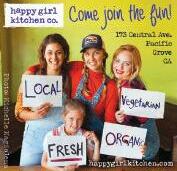
Food Lounge 1001 Center St., Santa Cruz scfoodlounge.com
A dynamic, community-minded venue featuring local artisanal products, special events, a bar and the products and services of resident collaborators Fogline Farm, Kickin’ Chicken, La Marea of the Sea, Lifestyle Culinary Arts, Ocean 2 Table and Tanglewood.
e Quail & Olive
3 Pilot Road, Carmel Valley 831.659.4288 | quailandolive.com
A boutique featuring quality, California olive oils and vinegars, as well as natural skin care products and cookbooks for better health.
62 edible MONTEREY BAYWINTER 2016
Shopper’s Corner
622 Soquel Ave., Santa Cruz 831.423.1398 | shopperscorner.com

Santa Cruz’s oldest and friendliest family-run market.
Star Market
1275 S. Main St., Salinas 831.422.3961 | starmkt.com
An independent grocer featuring the freshest, best tasting and finest selection of food in the Monterey Bay area; locally produced foods and wines are a specialty.
Stewart & Jasper Orchards
Monterey Plaza Hotel
400 Cannery Row, Ste. C, Monterey 831.375.6887 | stewartandjasper.com
A family-owned almond grower committed to quality, eco-friendly practices, water conservation and customer service.
Stone Creek Kitchen
465 Canyon del Rey Blvd., Monterey 831.393.1042 | stonecreekkitchen.com Our mission is to create a unique educational and culinary destination for epicureans on the Monterey Peninsula.
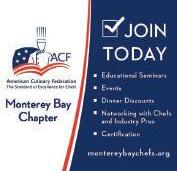
Troia Foods 801 Foam St., Monterey 831.375.3354 | troiafoods.com
A local dairy and fine food distributor for businesses.
Vertigo Coffee Roasters
81 Fourth St., San Juan Bautista 831.623.9533 | vertigocoffee.com
Specialty coffee roasters that also feature wood-fired cooking and craft beers.
e Wharf Marketplace
290 Figueroa St., Monterey 831.649.1116 | thewharfmarketplace.com
Monterey County’s fresh food destination, featuring the “bounty of the county”—locally produced provisions at their seasonal best.
SPECIALTY SHOPS AND GALLERIES
Annieglass

310 Harvest Drive, Watsonville 831.761.2041 x21 | annieglassstore.com
Locally designed and handmade slumped-glass plates, bowls and serving dishes that add famed art and style to the dining room.
Botanic and Luxe
701A Front St., Santa Cruz botanicandluxe.com
Botanic and Luxe is a lifestyle store in downtown Santa Cruz featuring home décor, gifts and botanicals.
La Sirena Nouveau & Vintage
328D Ingalls St., Santa Cruz 831.427.2766 | lasirenaantiques.com
La Sirena has assembled the most eclectic selection of wonderful treasures, decor and boutique clothing, all nestled on Santa Cruz’s hip Westside.
Last Chance Mercantile/MRWMD 14201 Del Monte Blvd., Marina 831.264.6900 | mrwmd.org
Last Chance Mercantile provides convenient dropoff for reusable goods and an ever-changing inventory of affordable, preowned and salvaged items for purchase.
Pacific Trading Co. 1224 Pacific Ave., Santa Cruz | 831.423.3349 504C Bay Ave., Capitola | 831.476.6109 facebook.com/pages/pacific-trading-co/65027935549 Independent, local, family-owned women’s apparel boutique.
Seven Bridges Cooperative
325A River St., Santa Cruz 831.454.9665 | breworganic.com

e local source for certified-organic homebrew ingredients and equipment.
Sojourn Box Santa Cruz 831.566.7136 | sojournbox.com Curated gift boxes featuring local artisan products.
WINERIES AND TASTING ROOMS
Beauregard Vineyards
10 Pine Flat Road, Santa Cruz 831.425.7777 | beauregardvineyards.com
Sustainably produced wines expressing the terroir of the Santa Cruz Mountains through minimal impact winemaking.
Carmel Valley Wine Experience cvwineexperience.com
A group of tasting rooms offering a unique way to experience wines in the Carmel Valley sunshine. Members include:
Bernardus Winery
5 W. Carmel Valley Road, Carmel Valley 831.298.8021 | bernardus.com
Big Sur Vineyards Tasting Room
3 Del Fino Place, Carmel Valley 831.652.3020 | bigsurvineyards.com
Bunter Spring Winery
9 Del Fino Place, Ste. 102, Carmel Valley 202.744.1343 | bunterspringwinery.com
Chesebro Wines
19 E. Carmel Valley Road, Carmel Valley 831.659.2125 | chesebrowines.com
Cima Collina
19 E. Carmel Valley Road, Carmel Valley 831.620.0645 | cimacollina.com
Holman Ranch
19 E. Carmel Valley Road, Carmel Valley 831.659.2640 | holmanranch.com
Idle Hour Winery
9 Del Fino Place, Carmel Valley 831.298.7526 | idlehourwinery.com
Jarman Tasting Room
18 W. Carmel Valley Road, Carmel Valley 831.298.7300 | jarmanwine.com
Joullian Vineyards
2 Village Drive, Carmel Valley 831.659.8100 | joullian.com
Joyce Vineyards
19 E. Carmel Valley Road, Carmel Valley 831.659.2885 | joycevineyards.com
Mercy Wines
40 W. Carmel Valley Road, Ste. A, Carmel Valley 831.659.4321 | mercywines.com
Parsonage Family Winery
19 E. Carmel Valley Road, Carmel Valley 831.659.7322 | parsonagewine.com
Cima Collina Tasting Room
19 E. Carmel Valley Road, Carmel Valley 831.620.0645 | cimacollina.com
Award-winning, artisanal wines from small Monterey vineyards. Tasting room is located in a picturesque historic building.
McIntyre Tasting Studio
169 Crossroads Blvd., Carmel 831.626.6268 | mcintyrevineyards.com Small lot wines that embody the mountainous, maritime terroir.
Percheron-McFarland 46 4th St., Gonzales 831.675.2311 | percheron-mcfarland.com
Dedicated to a world-famous legacy of excellence in California Pinot Noir and Chardonnay.
Taste Morgan
e Crossroads Carmel 204 Crossroads Blvd., Carmel-by-the-Sea 831.626.3700 | morganwinery.com
e Taste Morgan visitors’ center brings the Lee family’s history and artisanal, vineyard-centric winemaking craft to life through a relaxed tasting experience.
www.ediblemontereybay.com 63
BY BAMBI EDLUND

LAST CALL


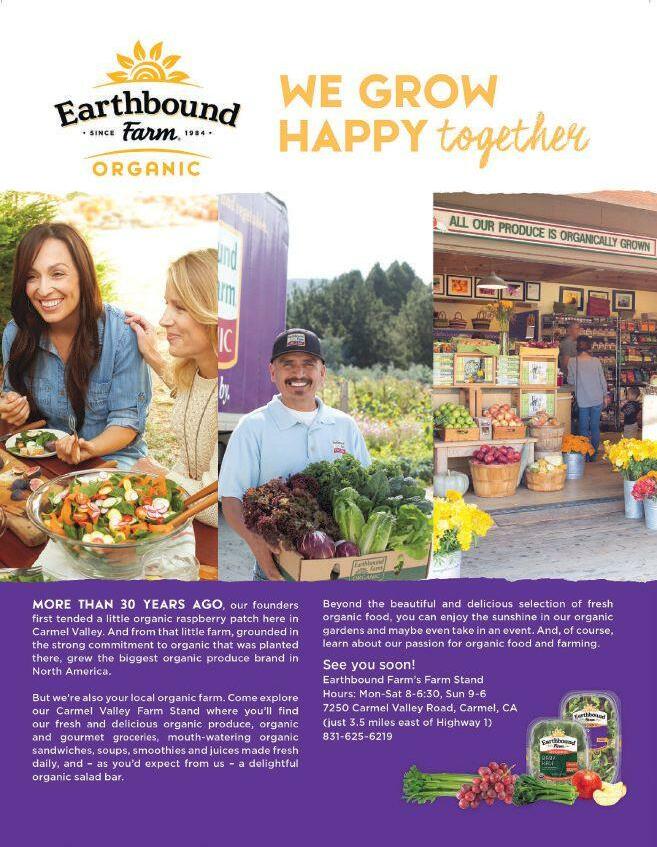

















 BY AMBER TURPIN
BY AMBER TURPIN






 BY PATRICE VECCHIONE PHOTOGRAPHY BY KEN PAYTON
BY PATRICE VECCHIONE PHOTOGRAPHY BY KEN PAYTON









 BY ROSIE PARKER PHOTOGRAPHY BY AMANDA PARGH
BY ROSIE PARKER PHOTOGRAPHY BY AMANDA PARGH


















 BY KATHRYN MCKENZIE • PHOTOGRAPHY BY KEN PAYTON
BY KATHRYN MCKENZIE • PHOTOGRAPHY BY KEN PAYTON



 BY ROSIE PARKER • PHOTOGRAPHY BY LARRY GERBRANDT
BY ROSIE PARKER • PHOTOGRAPHY BY LARRY GERBRANDT



























 BY CAMILLA M. MANN PHOTOGRAPHY BY MICHELLE MAGDALENA AND CAMILLA M. MANN
BY CAMILLA M. MANN PHOTOGRAPHY BY MICHELLE MAGDALENA AND CAMILLA M. MANN






 BY JORDAN CHAMPAGNE PHOTOGRAPHY BY MARGAUX GIBBONS AND MICHELLE MAGDALENA
BY JORDAN CHAMPAGNE PHOTOGRAPHY BY MARGAUX GIBBONS AND MICHELLE MAGDALENA































































































